
Photograph of the rock-cut Temple of Ellesiya in its original location within the Nubian landscape. Photograph taken shortly before the flood-waters would begin to rise and submerge the temple, due to the construction of the Aswan Dam.
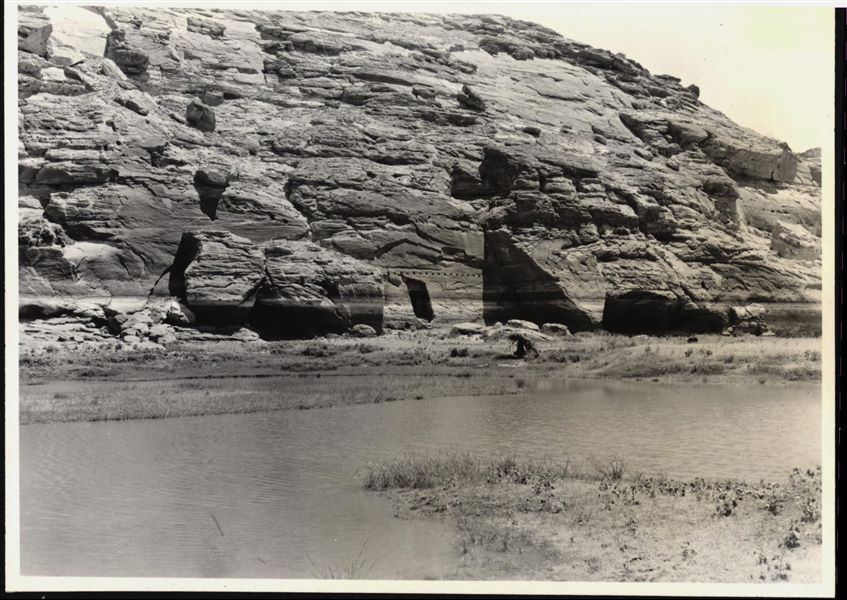
Photograph of the rock-cut Temple of Ellesiya in its original location within the Nubian landscape. In addition to the mountain (in which the temple was carved), the Nile River can be seen, which shortly afterwards, would begin to rise until it submerged the temple, due to the construction of the Aswan Dam.
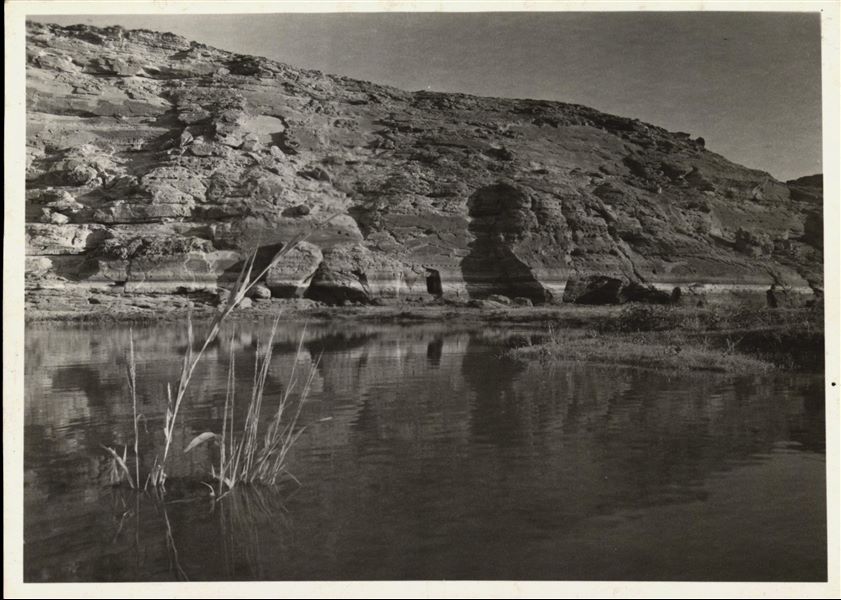
Photograph of the rock-cut Temple of Ellesiya in its original location within the Nubian landscape. In addition to the mountain (in which the temple was carved), the Nile River can be seen in the foreground, which shortly afterwards, would begin to rise until it submerged the temple, due to the construction of the Aswan Dam.
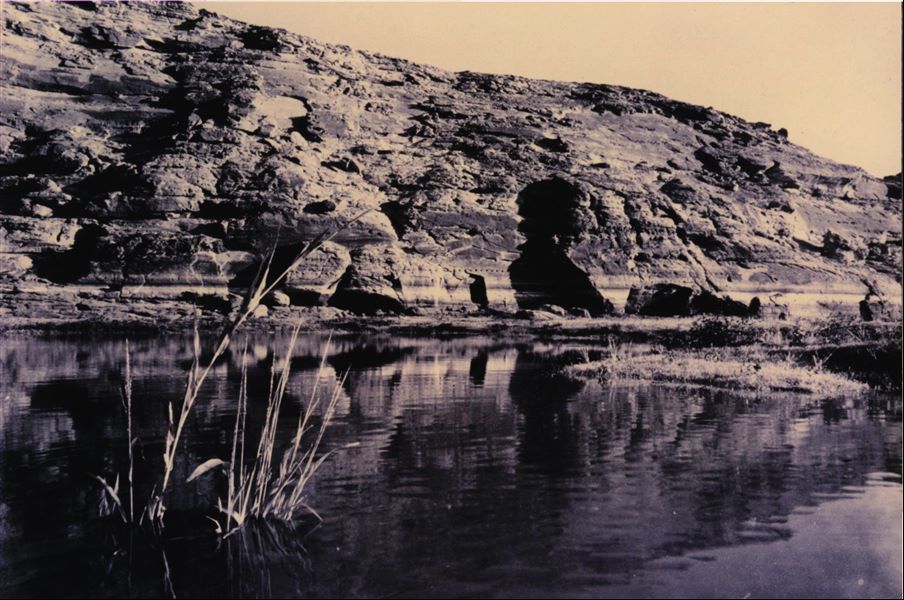
Photograph of the rock-cut Temple of Ellesiya in its original location within the Nubian landscape. In addition to the mountain (in which the temple was carved), the Nile River can be seen in the foreground, which shortly afterwards, would begin to rise until it submerged the temple, due to the construction of the Aswan Dam.
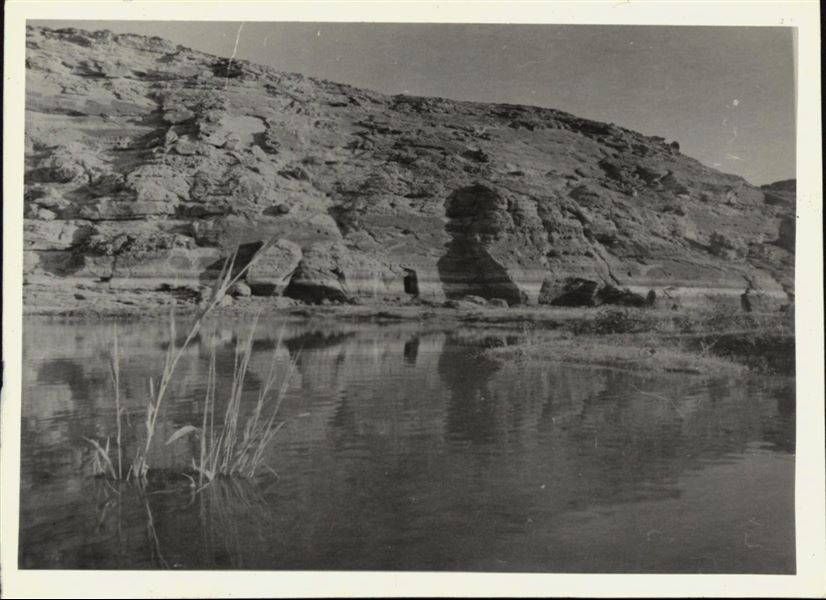
Photograph of the rock-cut Temple of Ellesiya in its original location within the Nubian landscape. In addition to the mountain (in which the temple was carved), the Nile River can be seen in the foreground, which shortly afterwards, would begin to rise until it submerged the temple, due to the construction of the Aswan Dam.
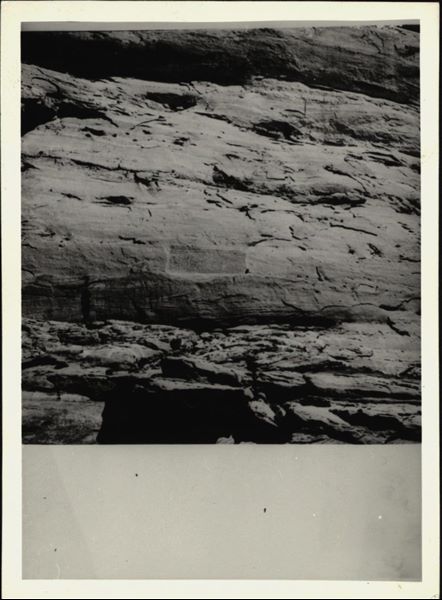
Photograph of the rock-cut Temple of Ellesiya in its original location within the Nubian landscape. In addition to the mountain (in which the temple was carved), the Nile River can be seen in the foreground, which shortly afterwards, would begin to rise until it submerged the temple, due to the construction of the Aswan Dam.

Photograph of an interior wall from the Temple of Ellesiya in its original location in Nubia, shortly before the Nile waters would begin to rise due to the construction of the Aswan Dam, which would flood the area. Photograph taken in the mid-1960s, shortly before the temple was moved. Note the original floor, which was not saved.

Photograph of an interior wall from the Temple of Ellesiya in its original location in Nubia, shortly before the Nile waters would begin to rise due to the construction of the Aswan Dam, which would flood the area. Photograph taken in the mid-1960s, shortly before the temple was moved. Note the original floor, which was not saved.
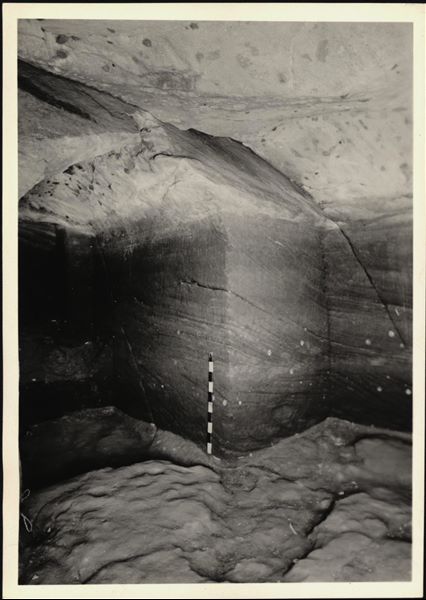
Photograph of an interior wall from the Temple of Ellesiya in its original location in Nubia, shortly before the Nile waters would begin to rise due to the construction of the Aswan Dam, which would flood the area. Photograph taken in the mid-1960s, shortly before the temple was moved. Note the original floor, which was not saved.
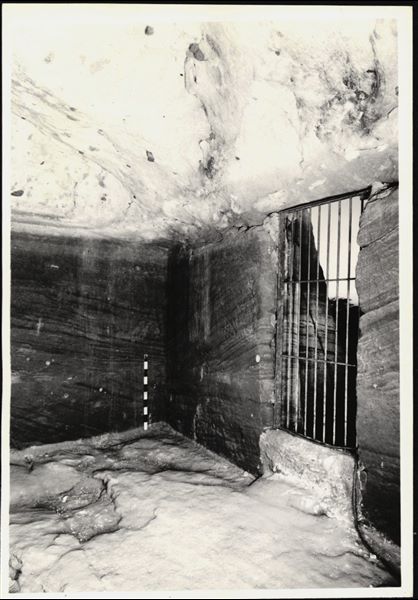
Photograph of an interior wall from the Temple of Ellesiya in its original location in Nubia, shortly before the Nile waters would begin to rise due to the construction of the Aswan Dam, which would flood the area. Photograph taken in the mid-1960s, shortly before the temple was moved. Note the original floor, which was not saved. Prior to the temple’s relocation, it was locked with a grate.
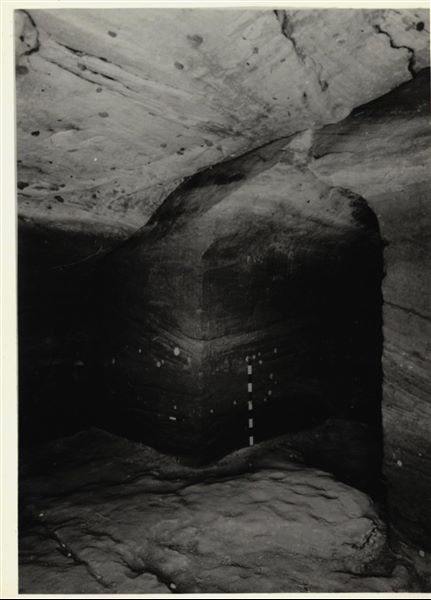
Photograph inside the Temple of Ellesiya in its original location in Nubia, shortly before the Nile waters would begin to rise due to the construction of the Aswan Dam, which would flood the area. Photograph taken in the mid-1960s, shortly before the temple was moved. Note the original floor, which was not saved.
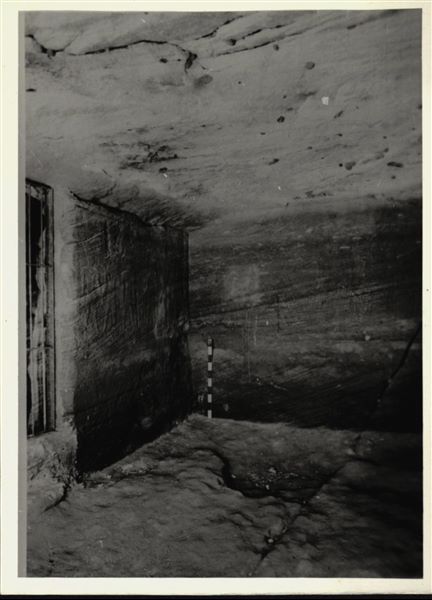
Photograph inside the Temple of Ellesiya in its original location in Nubia, shortly before the Nile waters would begin to rise due to the construction of the Aswan Dam, which would flood the area. Photograph taken in the mid-1960s, shortly before the temple was moved. Note the original floor, which was not saved.
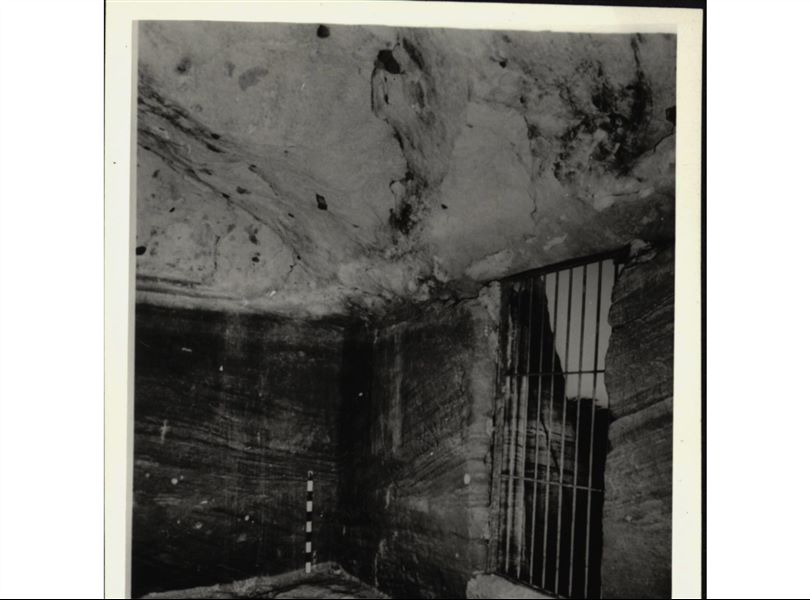
Photograph inside the Temple of Ellesiya, where the statues of deities and the pharaoh were located. The temple is in its original location in Nubia, shortly before the Nile waters would begin to rise due to the construction of the Aswan Dam, which would flood the area. Photograph taken in the mid-1960s, shortly before the temple was moved. Note the original floor, which was not saved. Prior to the temple’s relocation, it was locked with a grate.

Photograph of the back niche in the Temple of Ellesiya in its original location in Nubia, shortly before the Nile waters would begin to rise due to the construction of the Aswan Dam, which would flood the area. Photograph taken in the mid-1960s, shortly before the temple was moved. Note the original floor, which was not saved.
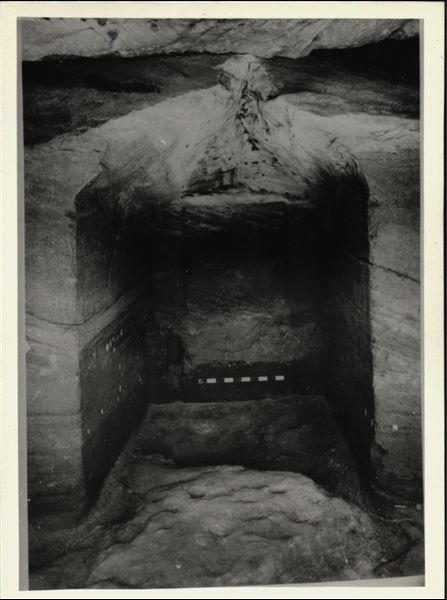
Photograph of the back niche in the Temple of Ellesiya in its original location in Nubia, shortly before the Nile waters would begin to rise due to the construction of the Aswan Dam, which would flood the area. Photograph taken in the mid-1960s, shortly before the temple was moved. Note the original floor, which was not saved.
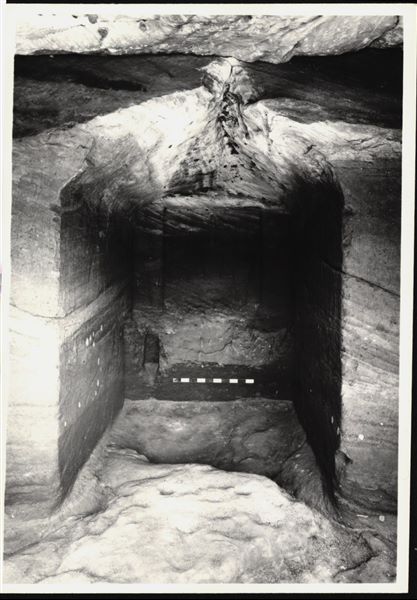
Photograph of the back niche in the Temple of Ellesiya, where the statues of deities and the pharaoh (Horus of Miam, Thutmosis III and Satet) were located. The temple is in its original location in Nubia, shortly before the Nile waters would begin to rise due to the construction of the Aswan Dam, which would flood the area. Photograph taken in the mid-1960s, shortly before the temple was moved. Note the original floor, which was not saved.

Photograph of the back niche in the Temple of Ellesiya, where the statues of deities and the pharaoh were located. The temple is in its original location in Nubia, shortly before the Nile waters would begin to rise due to the construction of the Aswan Dam, which would flood the area. Photograph taken in the mid-1960s, shortly before the temple was moved. Note the original floor, which was not saved.
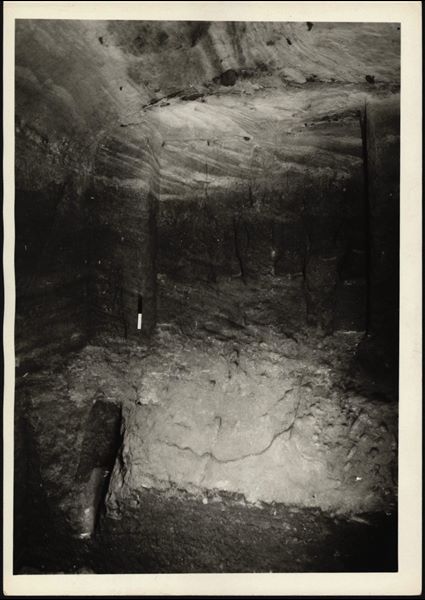
Photograph of the back niche in the Temple of Ellesiya, where the statues (just visible) of deities and the pharaoh were located. The temple is still in its original location in Nubia, shortly before the Nile waters would begin to rise due to the construction of the Aswan Dam, which would flood the area. Photograph taken in the mid-1960s, shortly before the temple was moved. Note the original floor, which was not saved.
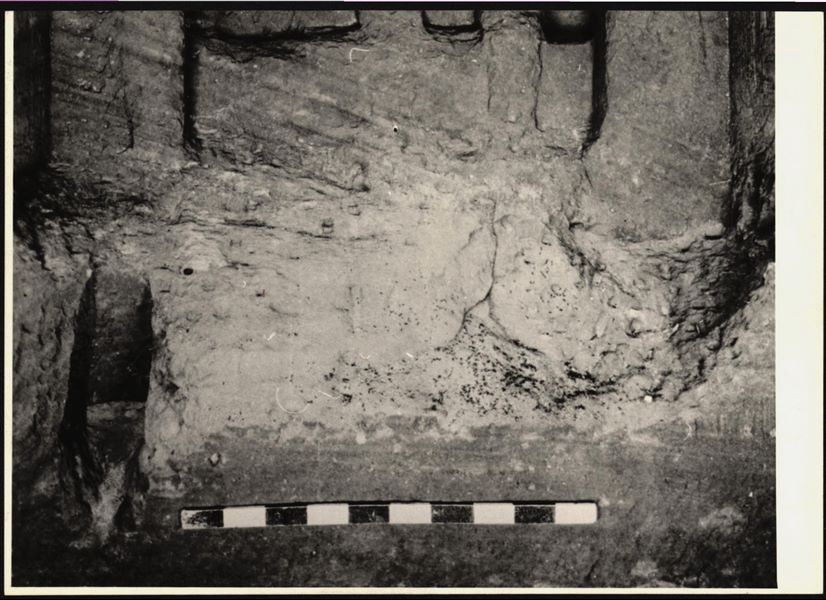
Photograph of the back niche in the Temple of Ellesiya, where the statues (just visible) of deities and the pharaoh were located. The temple is still in its original location in Nubia, shortly before the Nile waters would begin to rise due to the construction of the Aswan Dam, which would flood the area. Photograph taken in the mid-1960s, shortly before the temple was moved. Note the original floor, which was not saved.
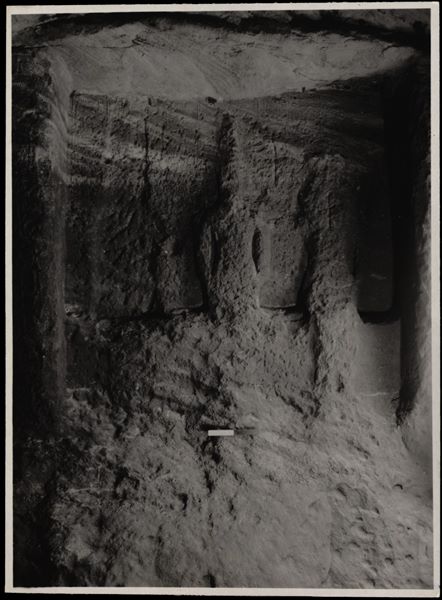
Photograph of the back niche in the Temple of Ellesiya in its original location in Nubia, shortly before the Nile waters would begin to rise due to the construction of the Aswan Dam, which would flood the area. Photograph taken in the mid-1960s, shortly before the temple was moved. The three statues than can be seen in the image are carved into the rock and depict Horus of Miam, the goddess Satet, and in the centre, the ruler Thutmosis III.
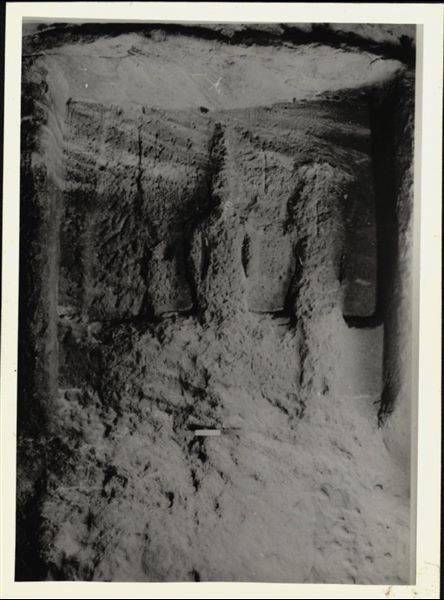
Photograph of the back niche in the Temple of Ellesiya, where the statues of deities and the pharaoh are located; depicting Horus of Miam, the goddess Satet, and in the centre, the ruler Thutmosis III. The photograph was taken in the temple’s original location in Nubia, shortly before the Nile waters would begin to rise due to the construction of the Aswan Dam, which would flood the area. Photograph taken in the mid-1960s, shortly before the temple was moved. Note the original floor, which was not saved.
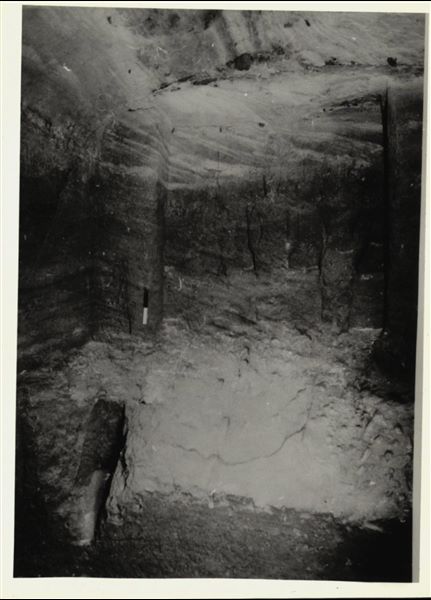
Photograph of the back niche in the Temple of Ellesiya, where the statues of deities and the pharaoh are located; depicting Horus of Miam, the goddess Satet, and in the centre, the ruler Thutmosis III. The photograph was taken in the temple’s original location in Nubia, shortly before the Nile waters would begin to rise due to the construction of the Aswan Dam, which would flood the area. Photograph taken in the mid-1960s, shortly before the temple was moved. Note the original floor, which was not saved.

Photograph of the back niche in the Temple of Ellesiya, where the statues of deities and the pharaoh are located; depicting Horus of Miam, the goddess Satet, and in the centre, the ruler Thutmosis III. The photograph was taken in the temple’s original location in Nubia, shortly before the Nile waters would begin to rise due to the construction of the Aswan Dam, which would flood the area. Photograph taken in the mid-1960s, shortly before the temple was moved. Note the original floor, which was not saved.
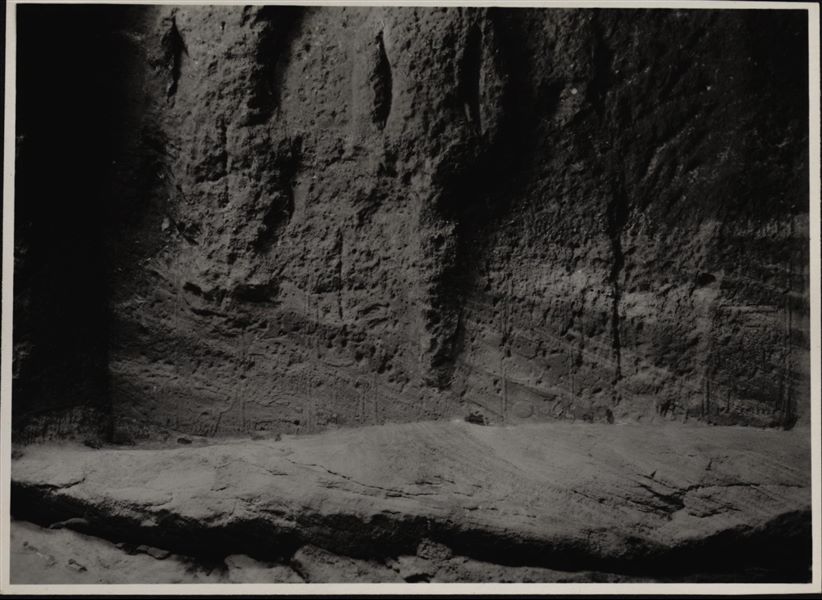
Photograph of the back wall of the niche, middle-bottom section in the Temple of Ellesiya. The temple is in its original location in Nubia, shortly before the Nile waters would begin to rise due to the construction of the Aswan Dam, which would flood the area. Photograph taken in the mid-1960s, shortly before the temple was moved.
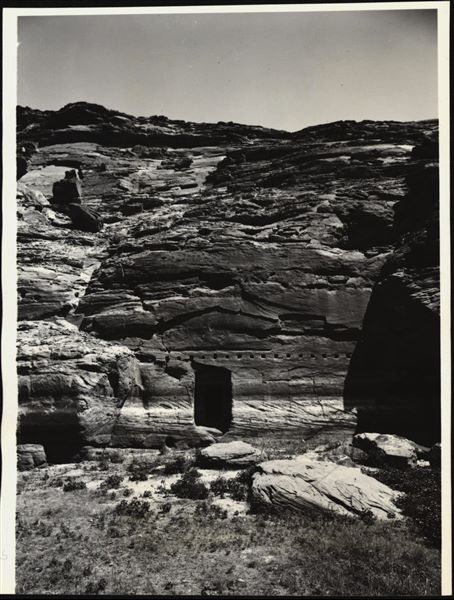
Photograph of the Temple of Ellesiya in its original location in Nubia, shortly before the Nile waters would begin to rise due to the construction of the Aswan Dam, which would flood the area. Photograph taken in the mid-1960s, shortly before the temple was moved.
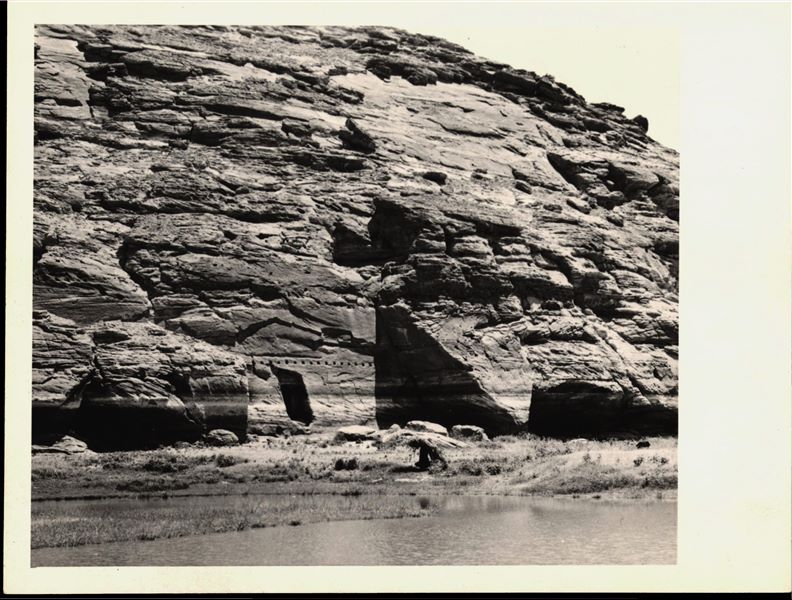
Photograph of the Temple of Ellesiya in its original location and of the plain in front of the temple, in Nubia. Photographed shortly before the Nile waters (visible in the foreground) would begin to rise due to the construction of the Aswan Dam, which would flood the area. Photo taken in the mid-1960s, shortly before the temple was moved.
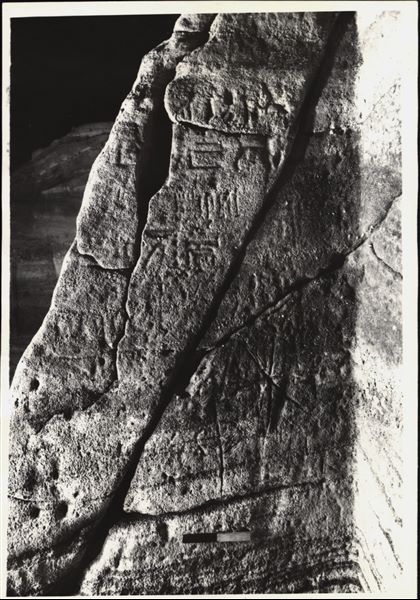
Photograph of a wall from the Temple of Ellesiya, shortly before it was moved. Photograph taken in the mid-1960s.
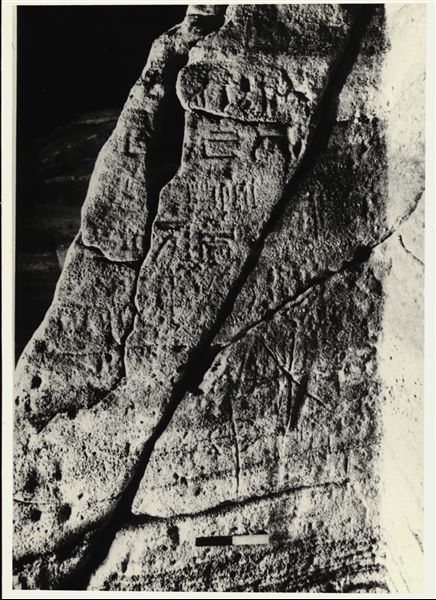
Photograph of a wall from the Temple of Ellesiya, shortly before it was moved. Photograph taken in the mid-1960s.
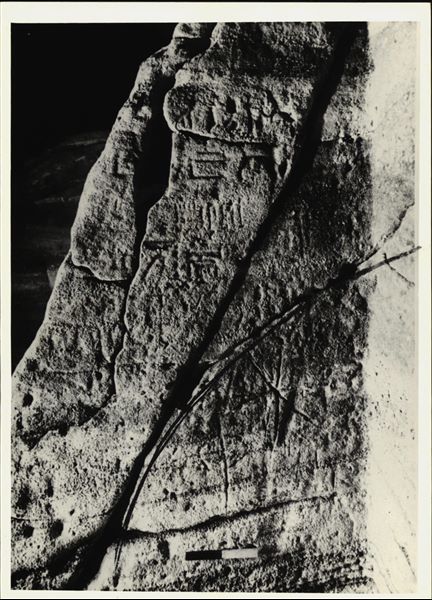
Photograph of a wall from the Temple of Ellesiya, shortly before it was moved. Photograph taken in the mid-1960s.
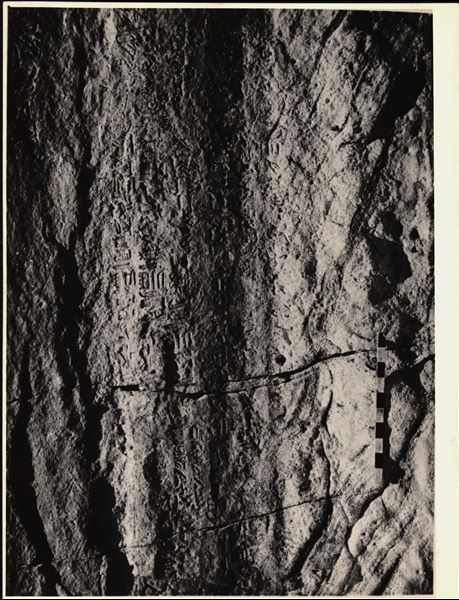
Photograph of a wall with inscriptions in hieroglyphs, from the Temple of Ellesiya, shortly before it was moved. Photograph taken in the mid-1960s.

Photograph of a wall with inscriptions in hieroglyphs, from the Temple of Ellesiya, shortly before it was moved. Photograph taken in the mid-1960s.
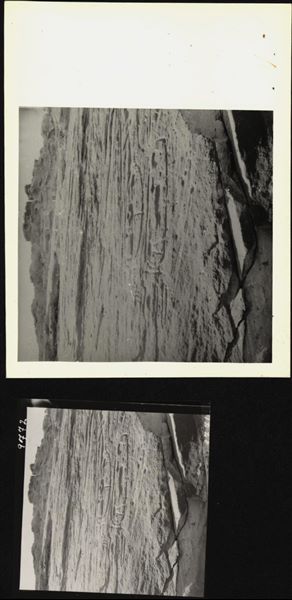
Photograph of a wall with inscriptions in hieroglyphs, from the Temple of Ellesiya, shortly before it was moved. Photograph taken in the mid-1960s.
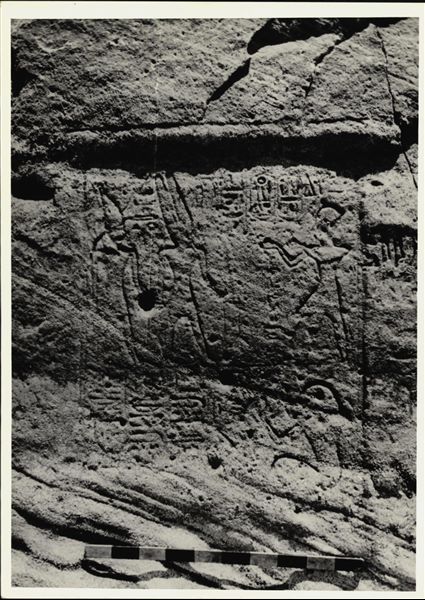
Photograph of a wall from the Temple of Ellesiya in its original location in Nubia, shortly before the Nile waters would begin to rise due to the construction of the Aswan Dam, which would flood the area. Photograph taken in the mid-1960s, shortly before the temple was moved.

Photograph of a wall from the Temple of Ellesiya in its original location in Nubia, shortly before the Nile waters would begin to rise due to the construction of the Aswan Dam, which would flood the area. Photograph taken in the mid-1960s, shortly before the temple was moved.

Photograph of a wall from the Temple of Ellesiya in its original location in Nubia, shortly before the Nile waters would begin to rise due to the construction of the Aswan Dam, which would flood the area. Photograph taken in the mid-1960s, shortly before the temple was moved.
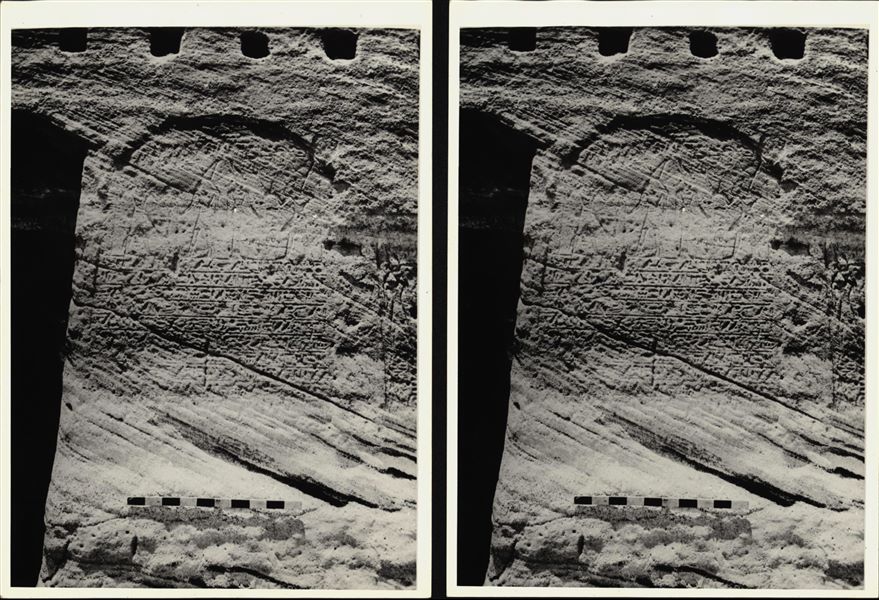
Photograph of a wall from the Temple of Ellesiya in its original location in Nubia, shortly before the Nile waters would begin to rise due to the construction of the Aswan Dam, which would flood the area. Photograph taken in the mid-1960s, shortly before the temple was moved.

Photograph of a wall from the Temple of Ellesiya in its original location in Nubia, shortly before the Nile waters would begin to rise due to the construction of the Aswan Dam, which would flood the area. Photograph taken in the mid-1960s, shortly before the temple was moved.

Photograph of a wall from the Temple of Ellesiya in its original location in Nubia, shortly before the Nile waters would begin to rise due to the construction of the Aswan Dam, which would flood the area. Photograph taken in the mid-1960s, shortly before the temple was moved.

Photograph of a wall from the Temple of Ellesiya in its original location in Nubia, shortly before the Nile waters would begin to rise due to the construction of the Aswan Dam, which would flood the area. Photograph taken in the mid-1960s, shortly before the temple was moved.
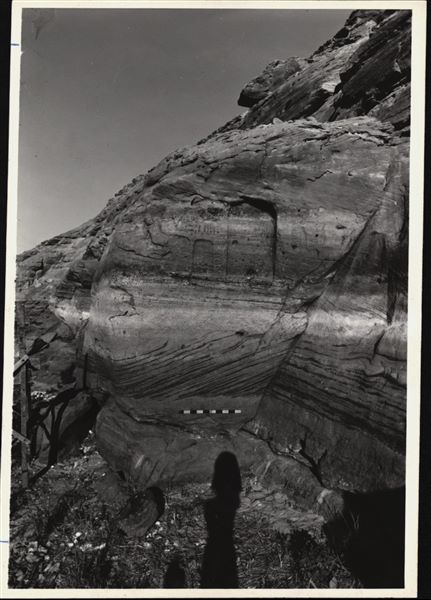
Photograph of a wall from the Temple of Ellesiya still in its original location in Nubia, shortly before the Nile waters would begin to rise due to the construction of the Aswan Dam, which would flood the area. Photograph taken in the mid-1960s, shortly before the temple was moved.
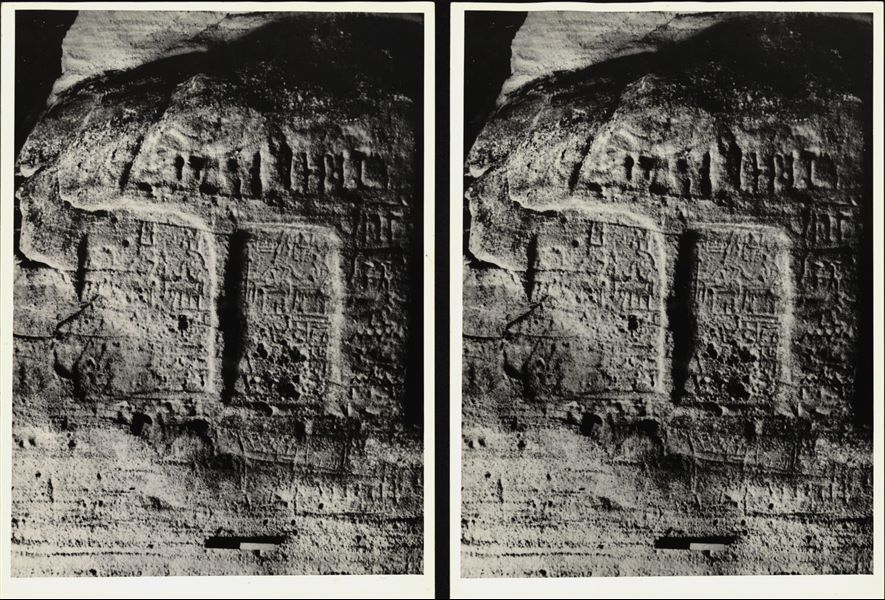
Photograph of a wall from the Temple of Ellesiya in its original location in Nubia, shortly before the Nile waters would begin to rise due to the construction of the Aswan Dam, which would flood the area. Photograph taken in the mid-1960s, shortly before the temple was moved.

Photograph of a wall from the Temple of Ellesiya in its original location in Nubia, shortly before the Nile waters would begin to rise due to the construction of the Aswan Dam, which would flood the area. Photograph taken in the mid-1960s, shortly before the temple was moved.

Photograph of a wall from the Temple of Ellesiya in its original location in Nubia, shortly before the Nile waters would begin to rise due to the construction of the Aswan Dam, which would flood the area. Photograph taken in the mid-1960s, shortly before the temple was moved.
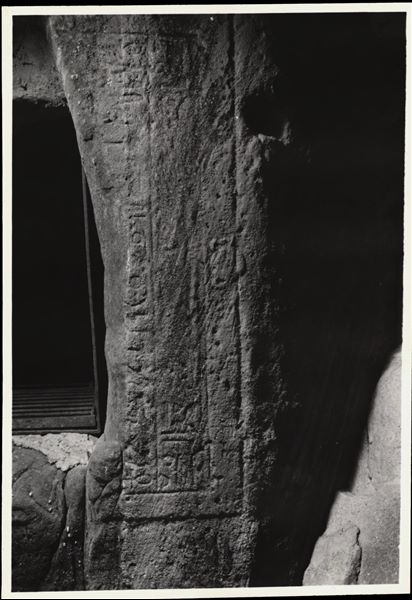
Photograph of a wall from the Temple of Ellesiya in its original location in Nubia, shortly before the Nile waters would begin to rise due to the construction of the Aswan Dam, which would flood the area. Photograph taken in the mid-1960s, shortly before the temple was moved.
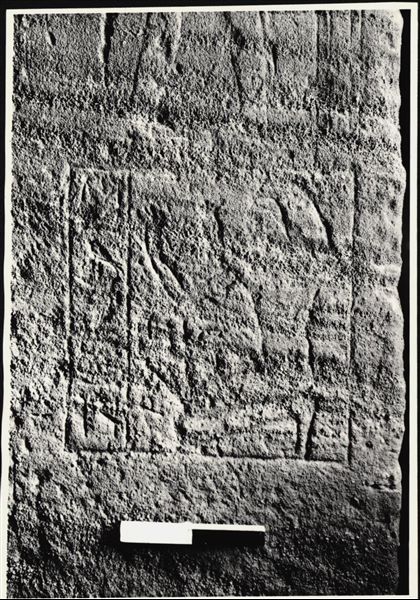
Photograph of a wall from the Temple of Ellesiya in its original location in Nubia, shortly before the Nile waters would begin to rise due to the construction of the Aswan Dam, which would flood the area. Photograph taken in the mid-1960s, shortly before the temple was moved.
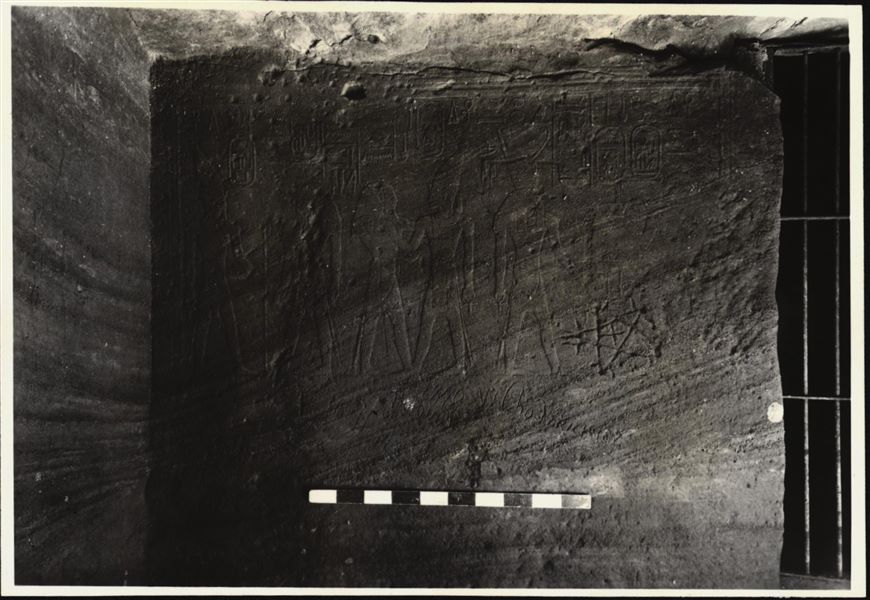
Photograph of a wall from the Temple of Ellesiya in its original location in Nubia, shortly before the Nile waters would begin to rise due to the construction of the Aswan Dam, which would flood the area. Photograph taken in the mid-1960s, shortly before the temple was moved.

Photograph of a wall from the Temple of Ellesiya in its original location in Nubia, shortly before the Nile waters would begin to rise due to the construction of the Aswan Dam, which would flood the area. Photograph taken in the mid-1960s, shortly before the temple was moved.

Photograph of a wall from the Temple of Ellesiya in its original location in Nubia, shortly before the Nile waters would begin to rise due to the construction of the Aswan Dam, which would flood the area. Photograph taken in the mid-1960s, shortly before the temple was moved.
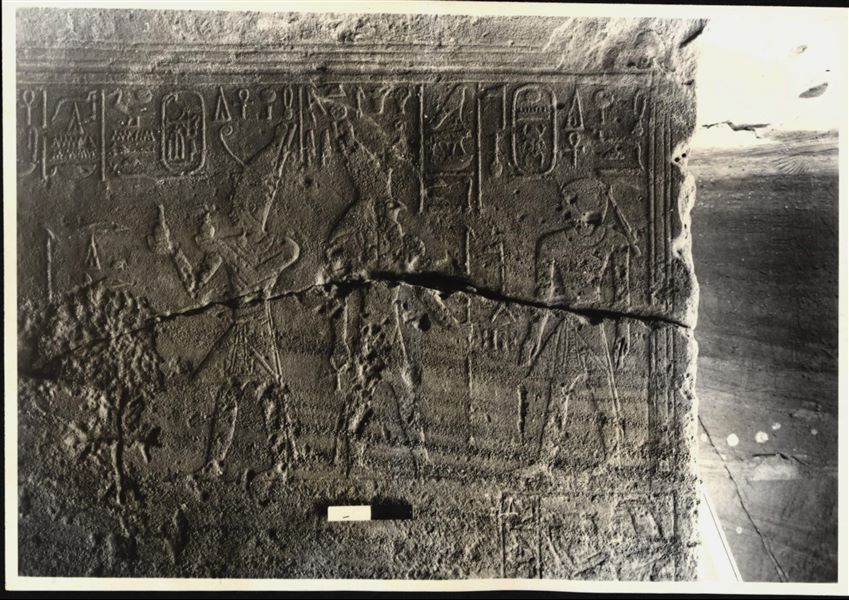
Photograph of a wall from the Temple of Ellesiya in its original location in Nubia, shortly before the Nile waters would begin to rise due to the construction of the Aswan Dam, which would flood the area. Photograph taken in the mid-1960s, shortly before the temple was moved.
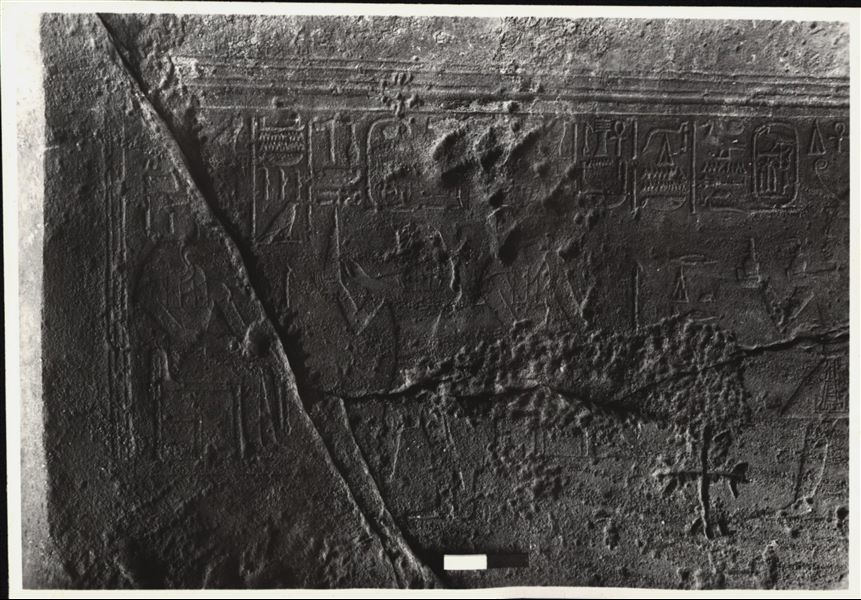
Photograph of a wall from the Temple of Ellesiya in its original location in Nubia, shortly before the Nile waters would begin to rise due to the construction of the Aswan Dam, which would flood the area. Photograph taken in the mid-1960s, shortly before the temple was moved.
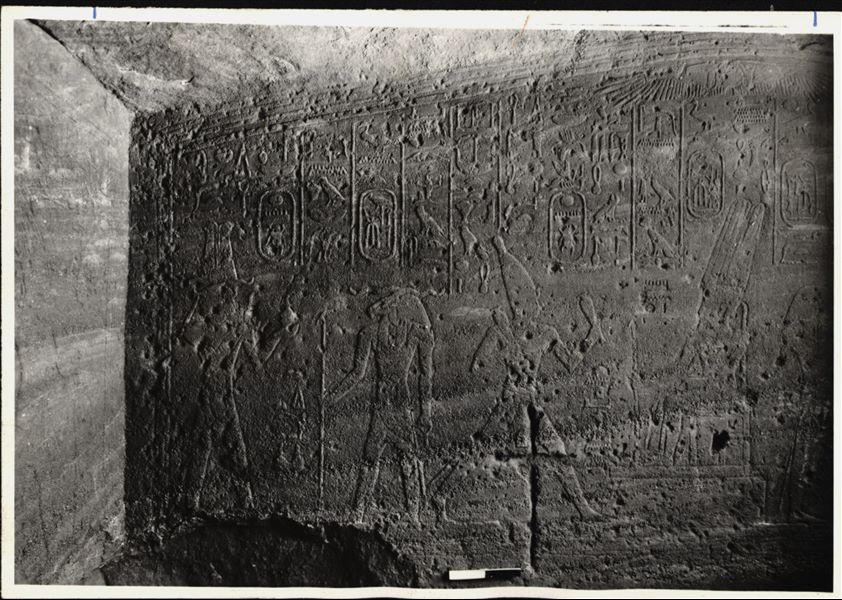
Photograph of a wall decoration from the Temple of Ellesiya in its original location in Nubia, shortly before the Nile waters would begin to rise due to the construction of the Aswan Dam, which would flood the area. Photograph taken in the mid-1960s, shortly before the temple was moved.

Photograph of a wall from the Temple of Ellesiya in its original location in Nubia, shortly before the Nile waters would begin to rise due to the construction of the Aswan Dam, which would flood the area. Photograph taken in the mid-1960s, shortly before the temple was moved.
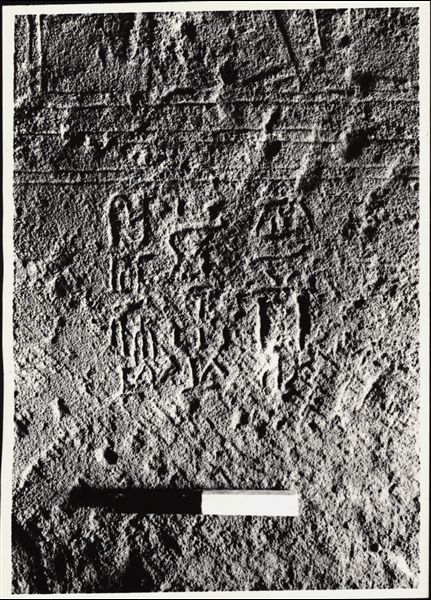
Photograph of an interior wall from the Temple of Ellesiya in its original location in Nubia, shortly before the Nile waters would begin to rise due to the construction of the Aswan Dam, which would flood the area. Photograph taken in the mid-1960s, shortly before the temple was moved.
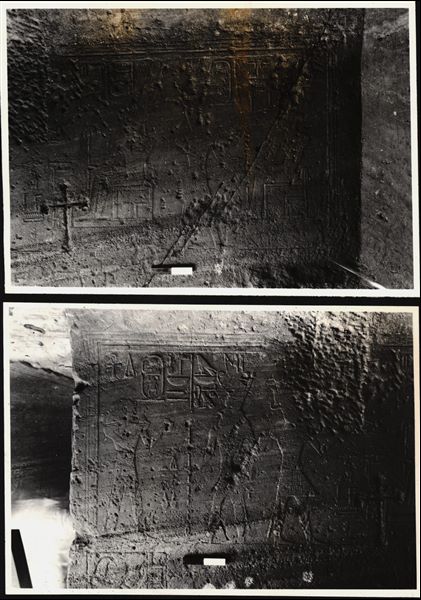
Two photographs of two interior walls from the Temple of Ellesiya in its original location in Nubia, shortly before the Nile waters would begin to rise due to the construction of the Aswan Dam, which would flood the area. Photograph taken in the mid-1960s, shortly before the temple was moved.

Photograph of an interior wall from the Temple of Ellesiya in its original location in Nubia, shortly before the Nile waters would begin to rise due to the construction of the Aswan Dam, which would flood the area. Photograph taken in the mid-1960s, shortly before the temple was moved.
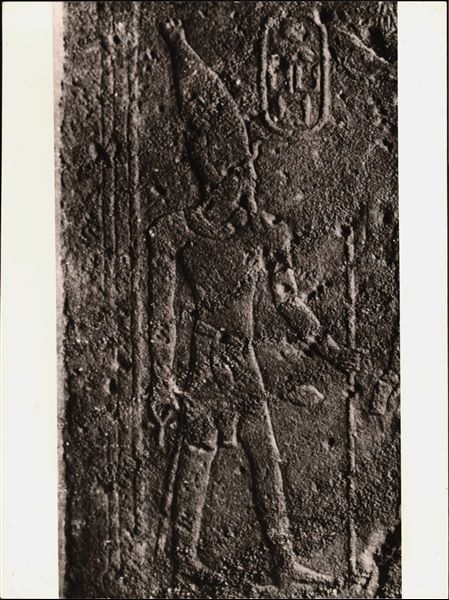
Photograph of an interior wall detail from the Temple of Ellesiya in its original location in Nubia, shortly before the Nile waters would begin to rise due to the construction of the Aswan Dam, which would flood the area. Photograph taken in the mid-1960s, shortly before the temple was moved.
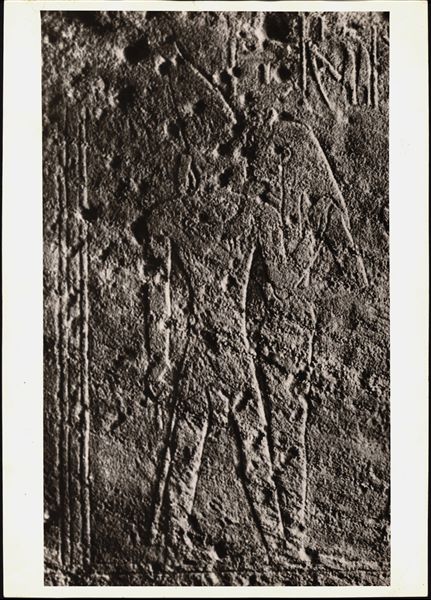
Photograph of an interior wall detail from the Temple of Ellesiya in its original location in Nubia, shortly before the Nile waters would begin to rise due to the construction of the Aswan Dam, which would flood the area. Photograph taken in the mid-1960s, shortly before the temple was moved.
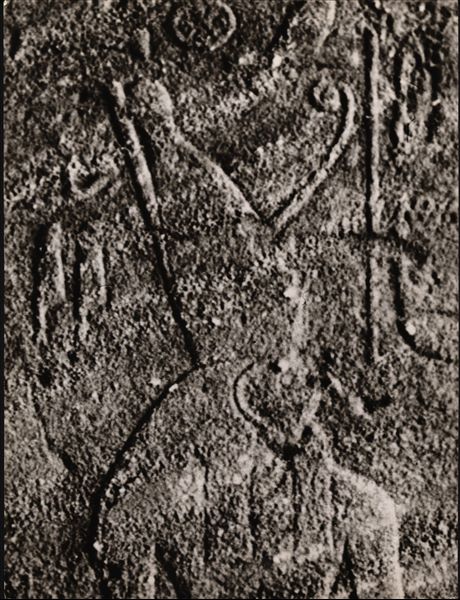
Photograph of an interior wall detail from the Temple of Ellesiya in its original location in Nubia, shortly before the Nile waters would begin to rise due to the construction of the Aswan Dam, which would flood the area. Photograph taken in the mid-1960s, shortly before the temple was moved.
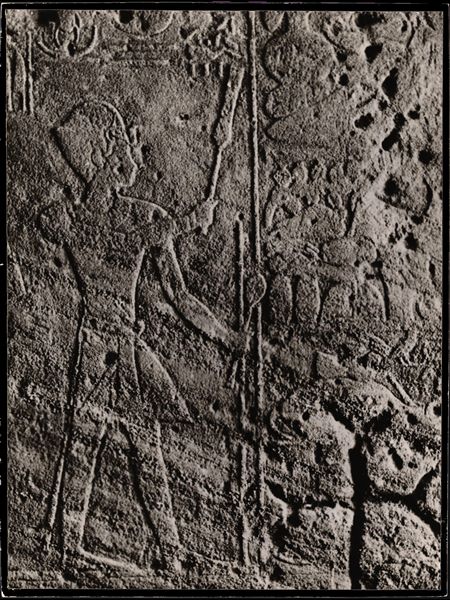
Photograph of a detail depicting Pharaoh Thutmosis III, from an interior wall in the Temple of Ellesiya. The temple is in its original location in Nubia, shortly before the Nile waters would begin to rise due to the construction of the Aswan Dam, which would flood the area. Photograph taken in the mid-1960s, shortly before the temple was moved.
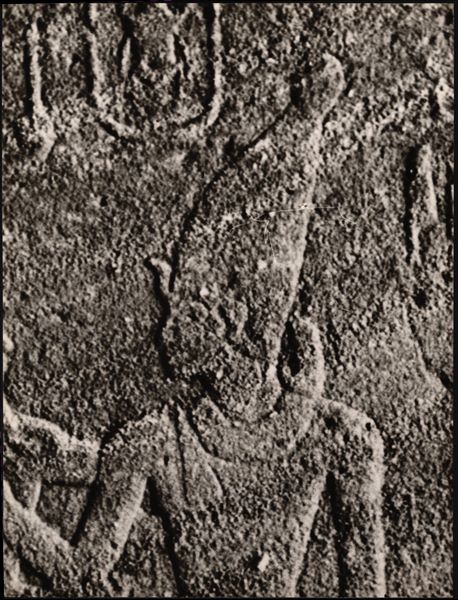
Photograph of a detail depicting Pharaoh Thutmosis III, from an interior wall in the Temple of Ellesiya. The temple is in its original location in Nubia, shortly before the Nile waters would begin to rise due to the construction of the Aswan Dam, which would flood the area. Photograph taken in the mid-1960s, shortly before the temple was moved.
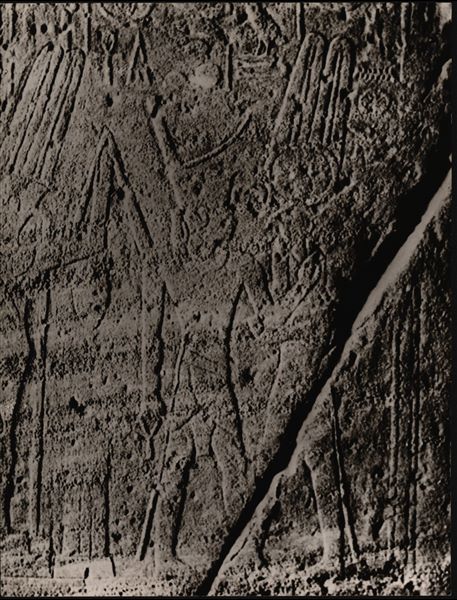
Photograph of a detail depicting Pharaoh Thutmosis III and the god Horus, from an interior wall in the Temple of Ellesiya. The temple is in its original location in Nubia, shortly before the Nile waters would begin to rise due to the construction of the Aswan Dam, which would flood the area. Photograph taken in the mid-1960s, shortly before the temple was moved.
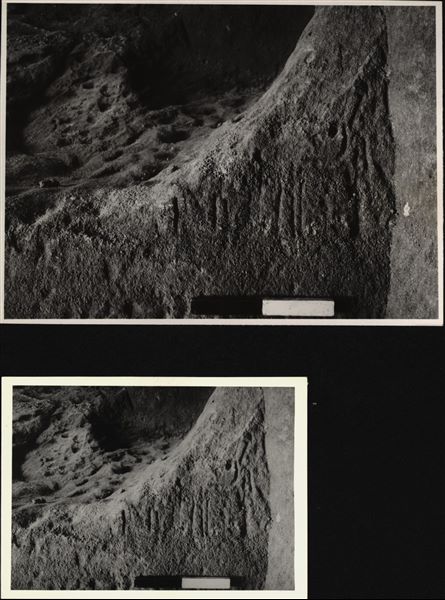
Two photographs of a detail from an interior wall in the Temple of Ellesiya. The temple is in its original location in Nubia, shortly before the Nile waters would begin to rise due to the construction of the Aswan Dam, which would flood the area. Photograph taken in the mid-1960s, shortly before the temple was moved.
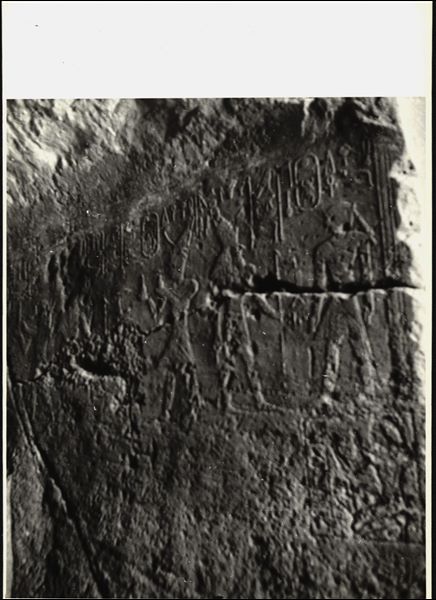
Photograph of an interior section from the Temple of Ellesiya, shortly before it was moved. Photograph taken in the mid-1960s.
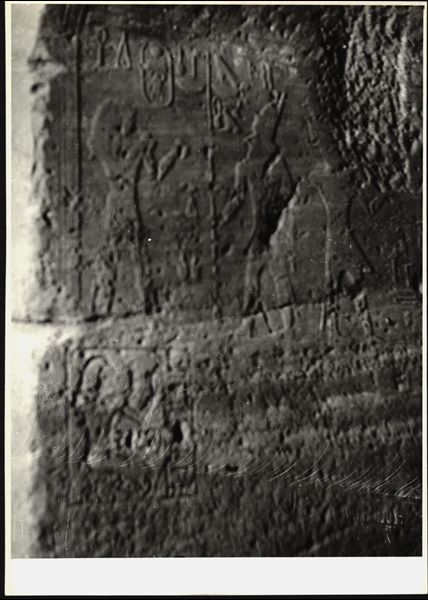
Photograph of an interior section from the Temple of Ellesiya, shortly before it was moved. Photograph taken in the mid-1960s.

Photograph of an interior section from the Temple of Ellesiya, shortly before it was moved. Photograph taken in the mid-1960s.
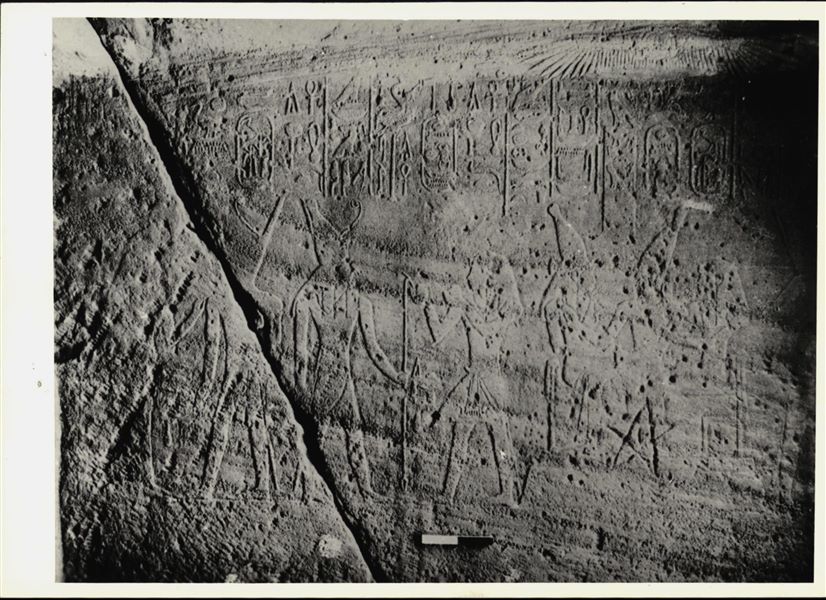
Photograph of an interior section from the Temple of Ellesiya, shortly before it was moved. Photograph taken in the mid-1960s. Scene with several deities, on the right side of the transverse chamber. An engraved five-pointed star is also visible.
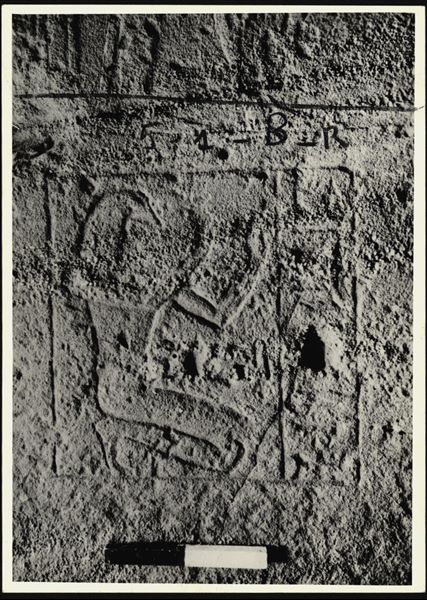
Photograph of an interior section from the Temple of Ellesiya, shortly before it was moved. Photograph taken in the mid-1960s.
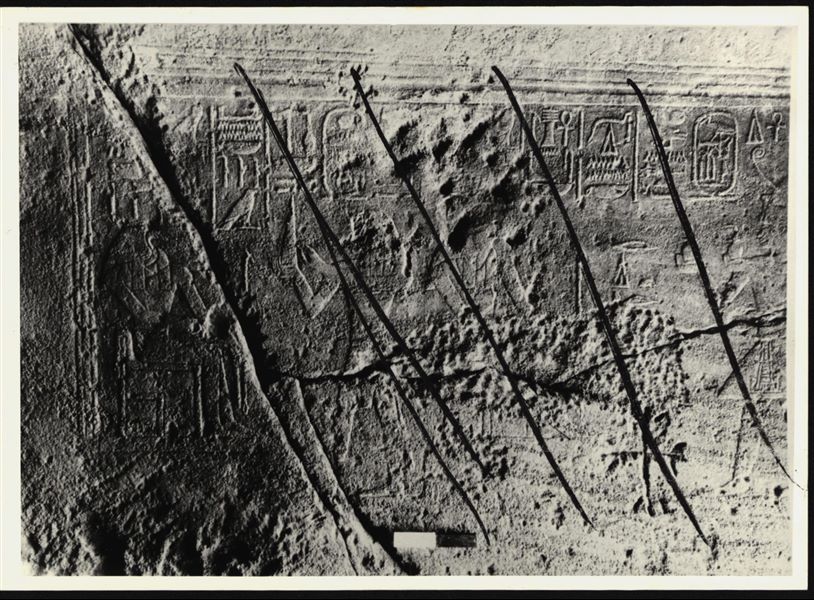
Photograph of an interior section from the Temple of Ellesiya, shortly before it was moved. Photograph taken in the mid-1960s. Right wall of the chamber. From the left: the god Thoth seated, Thutmosis III, Horus of Miam and Thutmosis III depicted again.
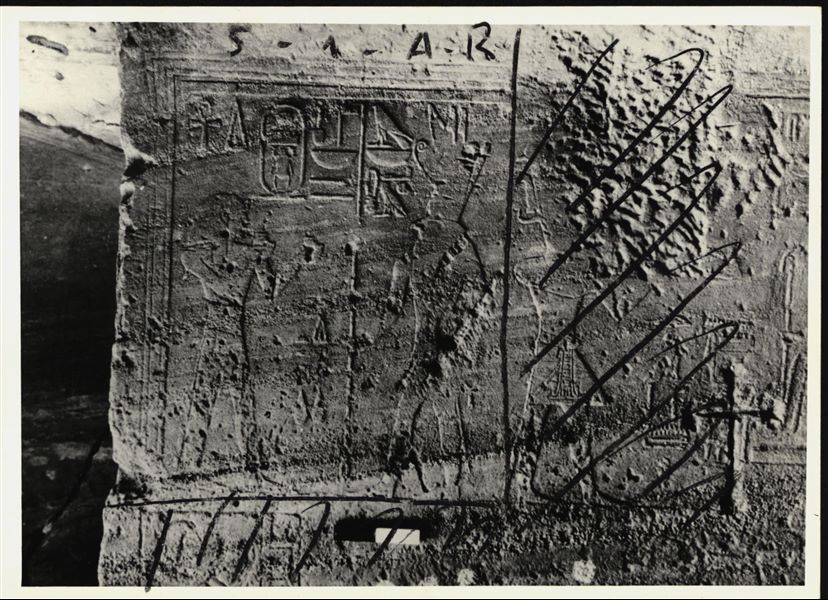
Photograph of an interior section from the Temple of Ellesiya, shortly before it was moved. Photograph taken in the mid-1960s. Left wall of the chamber, with the depictions of Thutmosis III and Horus of Miam.
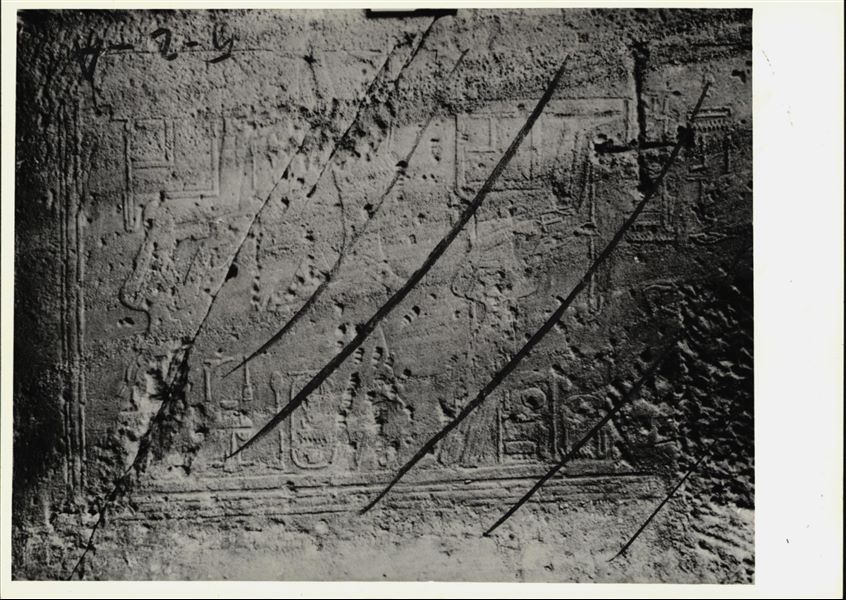
Photograph of an interior section from the Temple of Ellesiya, shortly before it was moved. Photograph taken in the mid-1960s. Depicted on the left wall of the chamber, from the left: Amun-Ra seated, Thutmosis III and the goddess Satet, also seated.

Photograph of an interior section from the Temple of Ellesiya, shortly before it was moved. Photograph taken in the mid-1960s. Visible on the left wall of the transverse chamber: the god Min on the left, and on the right, the god Montu who embraces the pharaoh.

Endowment stela (appannaggio stele) of Thutmosis III in the façade of the rock-cut Temple of Ellesiya, to the left of the entrance.

Two photographs taken during the rescue campaign of the rock-cut Temple of Ellesiya, when Lake Nasser, created by the construction of the Aswan Dam, was filling up.

Two photographs taken during the rescue campaign of the rock-cut Temple of Ellesiya, when Lake Nasser was filling up. Particularly visible are the scaffolding set up during the removal of the temple, and the workers employed. The water level was already rising, and in this shot, it is has already reached the entrance to the temple.
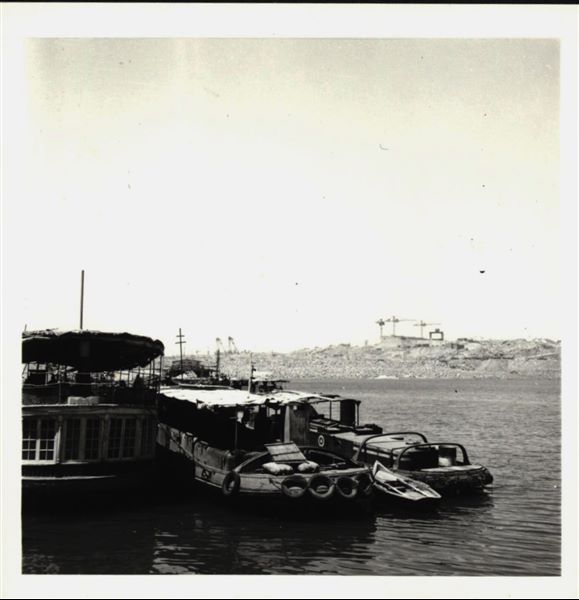
Photograph taken in the area of the site of Ellesiya, when Lake Nasser had already formed and was full. In the foreground, there are three boats for the transport and accommodation of the people who were working on the Temple of Ellesiya. In the background, there is a construction site in action.
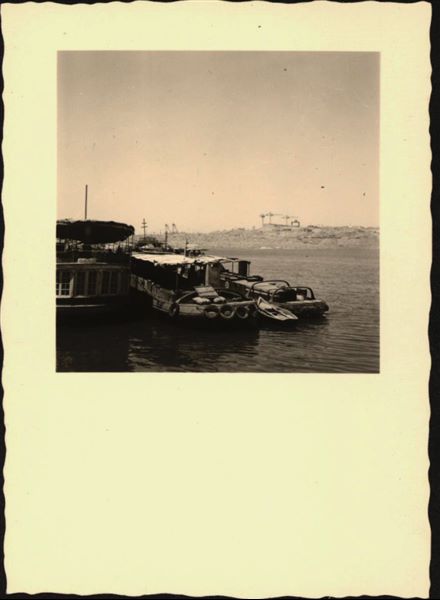
Photograph taken in the area of the site of Ellesiya, when Lake Nasser had already formed and was full. In the foreground, there are three boats for the transport and accommodation of the people who were working on the Temple of Ellesiya. In the background, there is a construction site in action.
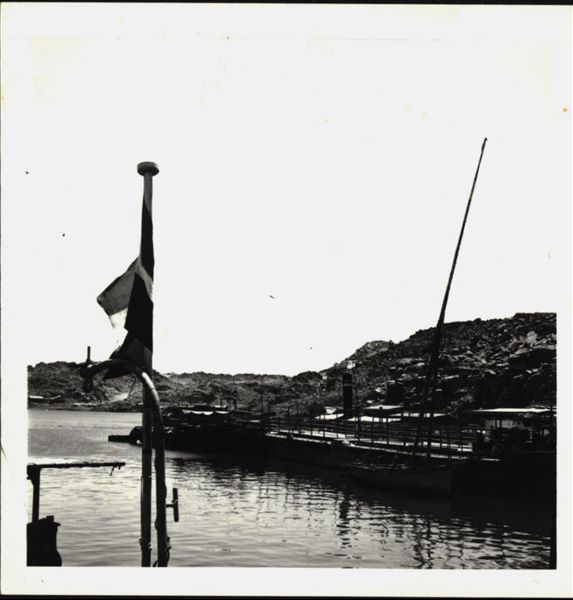
Photograph taken in the area of the site of Ellesiya, when Lake Nasser had already formed and was full. Some boats for transport are visible. In the background, the Nubian landscape.
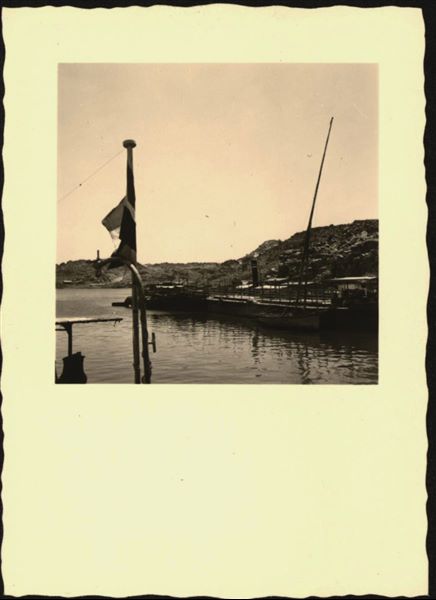
Photograph taken in the area of the site of Ellesiya, when Lake Nasser had already formed and was full. Some boats for transport are visible. In the background, the Nubian landscape.

Photograph taken in the area of the site of Ellesiya, when Lake Nasser had already formed and was full. Three trees can be seen popping out of the lake, bound to be submerged. In the background, the Nubian landscape.

Photograph taken in the area of the site of Ellesiya, when Lake Nasser had already formed and was full. Three trees can be seen popping out of the lake, bound to be submerged. In the background, the Nubian landscape.
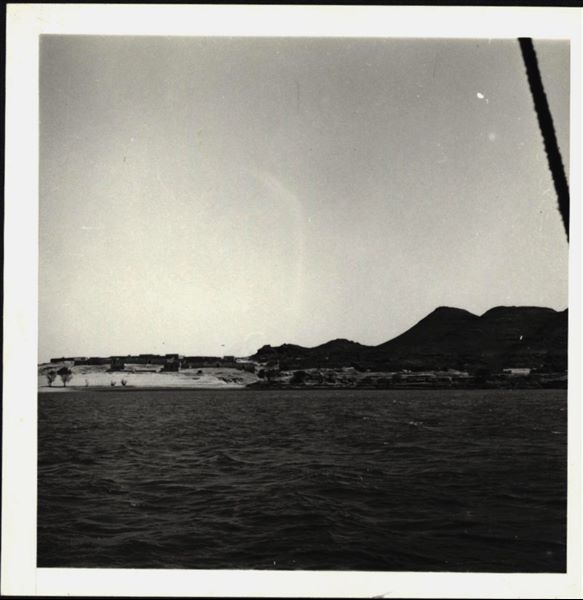
Photograph taken in the area of the site of Ellesiya, when Lake Nasser had already formed and was full. In the background, the Nubian landscape.
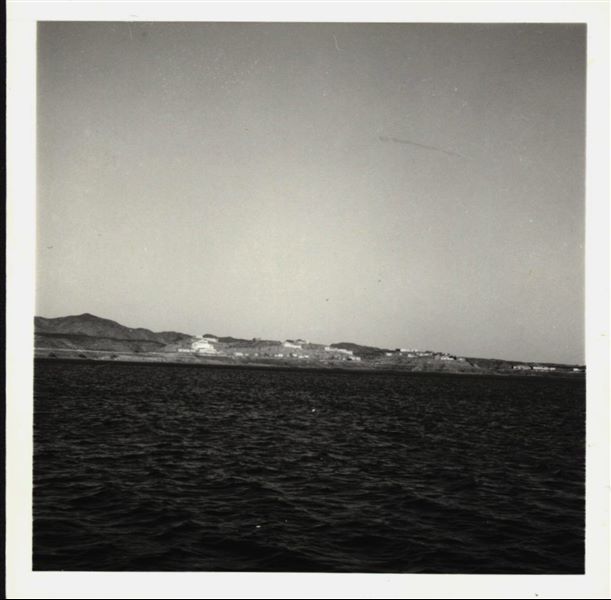
Photograph taken in the area of the site of Ellesiya, when Lake Nasser had already formed and was full. In the background, the Nubian landscape.
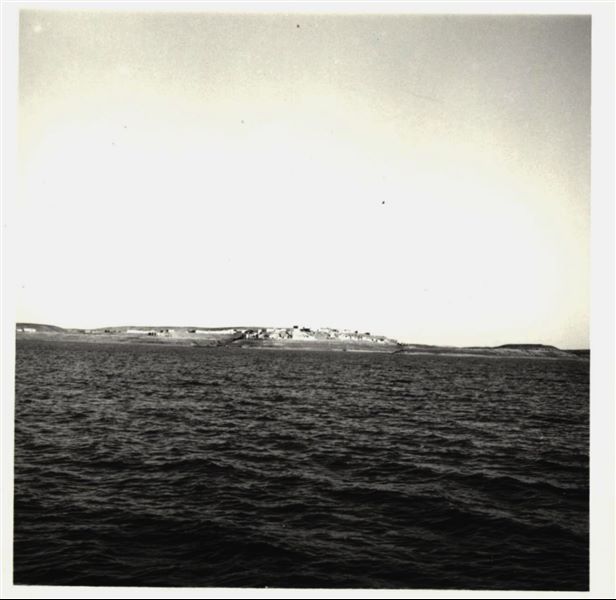
Photograph taken in the area of the site of Ellesiya, when Lake Nasser had already formed and was full. In the background, the Nubian landscape.
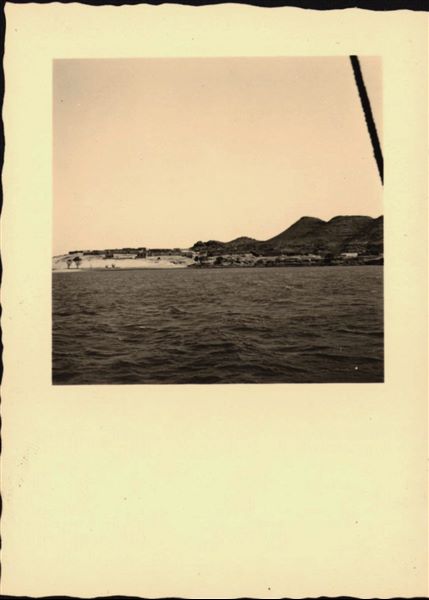
Photograph taken in the area of the site of Ellesiya, when Lake Nasser had already formed and was full. In the background, the Nubian landscape.

Photograph taken in the area of the site of Ellesiya, when Lake Nasser had already formed and was full. In the background, the Nubian landscape.
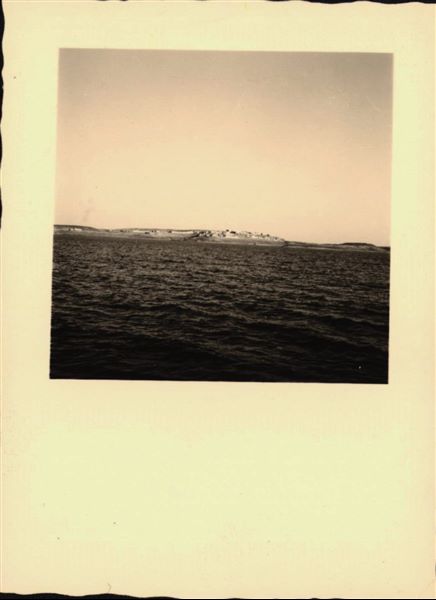
Photograph taken in the area of the site of Ellesiya, when Lake Nasser had already formed and was full. In the background, the Nubian landscape.
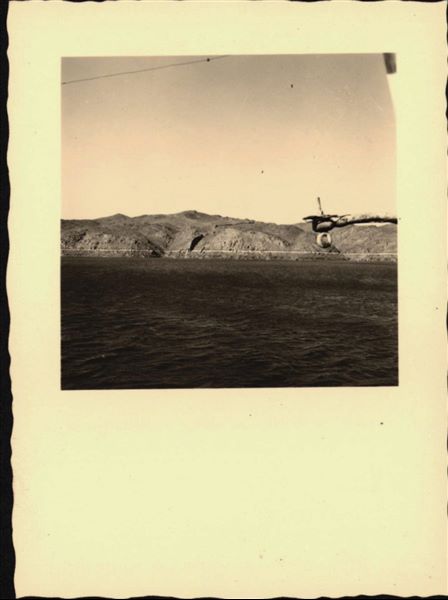
Photograph taken in the area of the site of Ellesiya, when Lake Nasser had already formed and was full. In the background, the Nubian landscape.
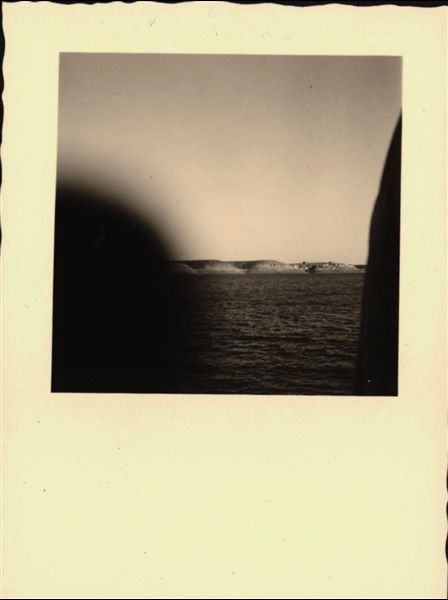
Photograph taken in the area of the site of Ellesiya, when Lake Nasser had already formed and was full. In the background, the Nubian landscape.
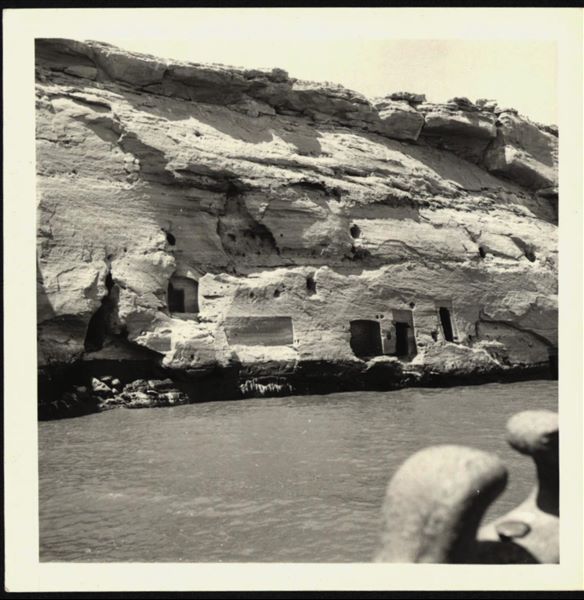
Photograph taken in the area of the rock-cut chapel in Qasr Ibrim, where some rooms and openings carved into the rock can be seen.
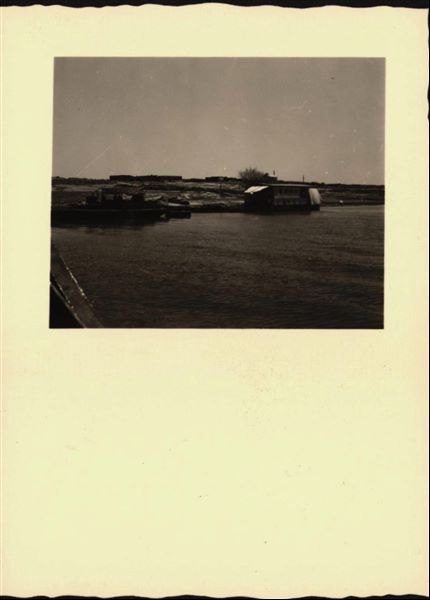
Photograph taken in the area of the site of Ellesiya, when Lake Nasser had already formed and was full. There are some boats for the transport and accommodation of the people who were working on the rock-cut Temple of Ellesiya.
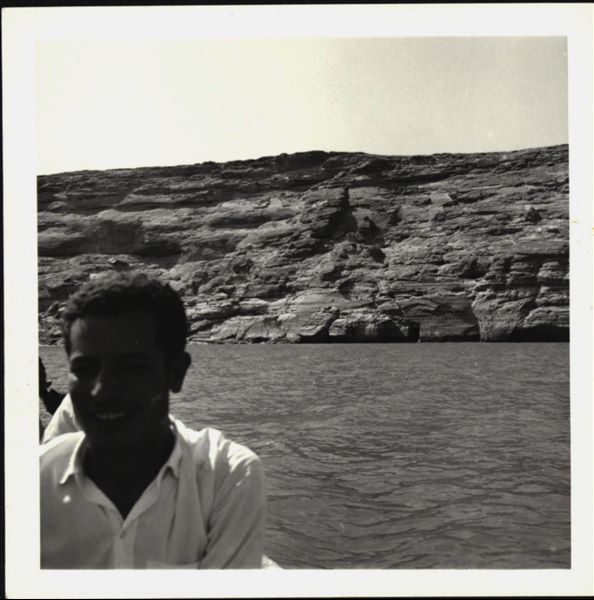
Photograph taken in the direction of the rock-cut Temple of Ellesiya that can be seen in the background. In a short time, the temple would have been submerged by Lake Nasser, which had already formed and was full. Photograph taken from a boat.

Photograph taken in the direction of the rock-cut Temple of Ellesiya that can be seen in the background. In a short time, the temple would have been submerged by Lake Nasser, which had already formed and was full. Photograph taken from a boat.

Photograph taken in the direction of the rock-cut Temple of Ellesiya that can be seen in the background. In a short time, the temple would have been submerged by the growing Lake Nasser, which had already formed and was quite large. Photograph taken from a boat.
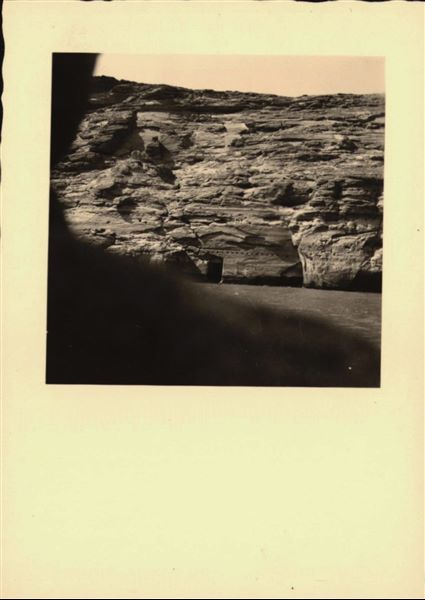
Photograph taken in the direction of the rock-cut Temple of Ellesiya that can be seen in the background. In a short time, the temple would have been submerged by the growing Lake Nasser, which had already formed and was quite large. Photograph taken from a boat.
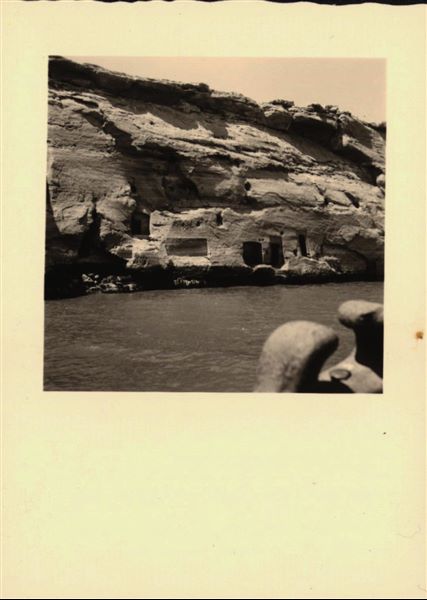
Photograph taken in the area of Qasr Ibrim, where some rooms and openings carved into the rock can be seen. Photograph taken from a boat.
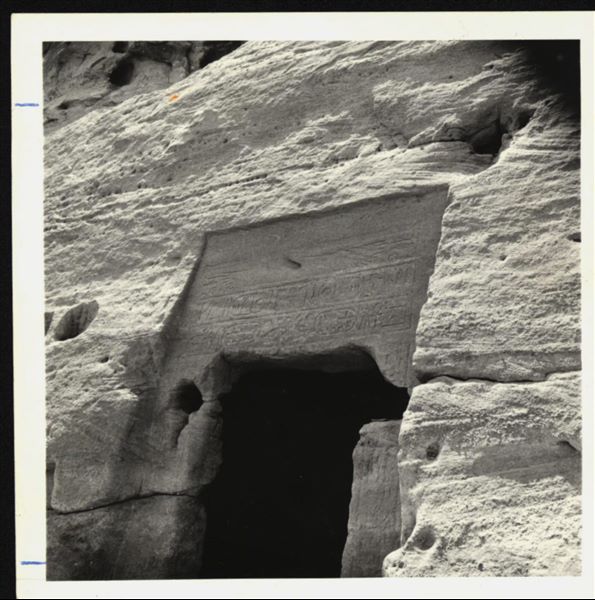
Photograph taken in the area of the rock-cut chapel in Qasr Ibrim, where some rooms and openings carved into the rock can be seen.

Photograph of a stela carved into the façade of the rock-cut Temple of Ellesiya. Photograph taken during the rising of Lake Nasser, which would have submerged this area.

Photograph of a stela carved into the façade of the rock-cut Temple of Ellesiya. Photograph taken during the rising of Lake Nasser, which would have submerged this area.
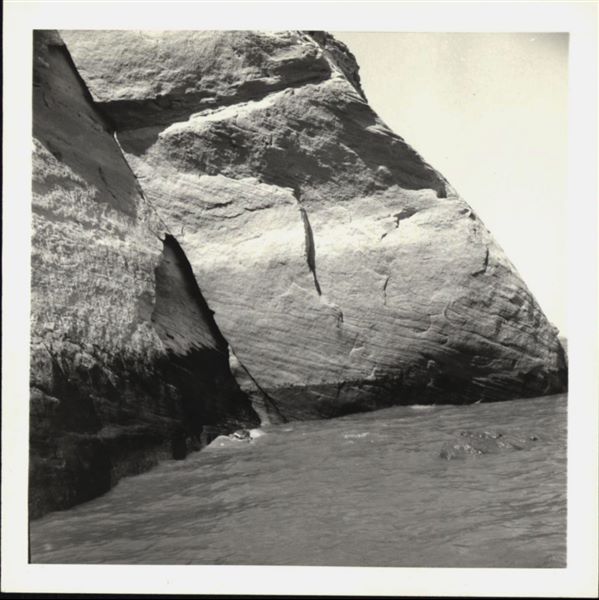
Photograph of the side facade wall from the Temple of Ellesiya, documenting the rising waters of Lake Nasser, which in a short time would have submerged the entire temple. Photograph taken from a boat.

Photograph of the side facade wall from the Temple of Ellesiya, showing the rising waters of Lake Nasser, which in a short time would have submerged the entire temple. Photograph taken from a boat.

Photograph of the side facade wall from the Temple of Ellesiya, showing the rising waters of Lake Nasser, which in a short time would have submerged the entire temple. Photograph taken from a boat.
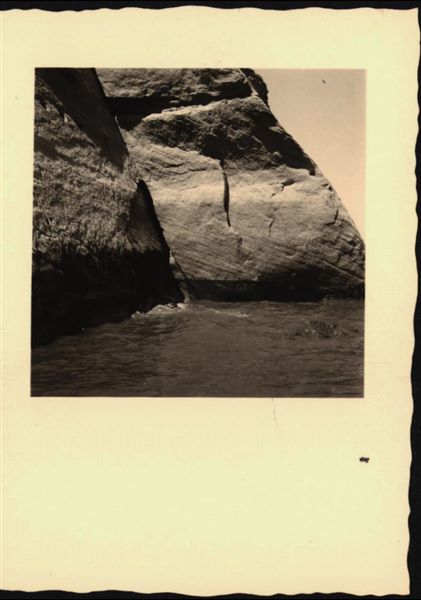
Photograph of the side facade wall from the Temple of Ellesiya, showing the rising waters of Lake Nasser, which in a short time would have submerged the entire temple. Photograph taken from a boat.
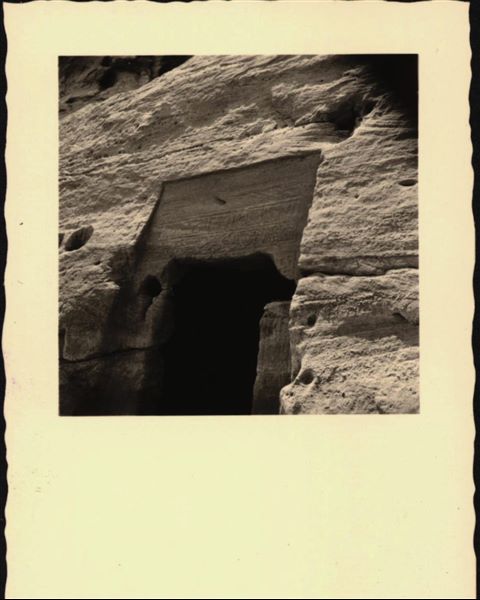
Detail of a rock-cut room with inscriptions and cartouches of Amenhotep II, in the area of the Temple of Ellesiya. Photograph taken during the rising of Lake Nasser, which would have submerged this area.
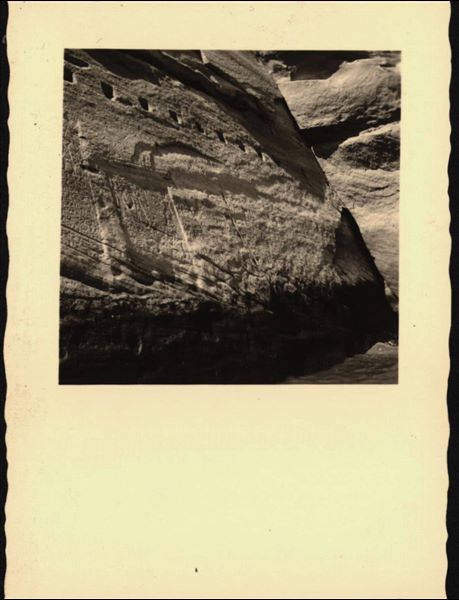
Detail of a stela carved into the right-side façade of the rock-cut Temple of Ellesiya. Photograph taken during the rising of Lake Nasser, which would have submerged this area.
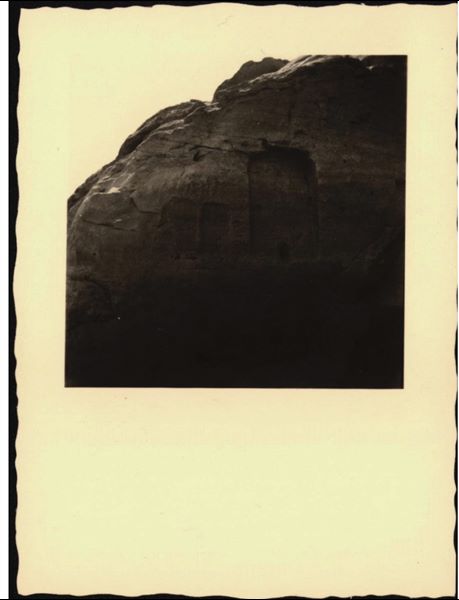
Detail of two stelae carved into the left-side façade of the rock-cut Temple of Ellesiya. Photograph taken during the rising of Lake Nasser, which would have submerged this area.
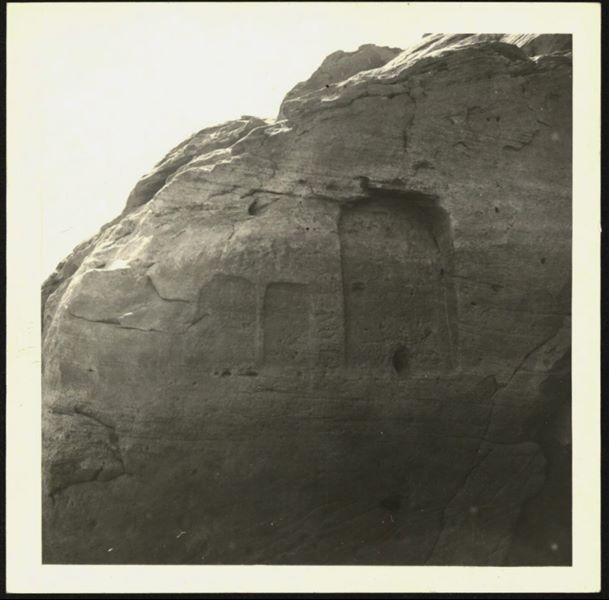
Detail of two stelae carved into the left side façade of the rock-cut Temple of Ellesiya. Photograph taken during the rising of Lake Nasser, which would have submerged this area.

Photograph taken in front of the rock-cut Temple of Ellesiya (the holes in the side of the rock to affix poles are notable), during the rising of Lake Nasser, which would have submerged this area.
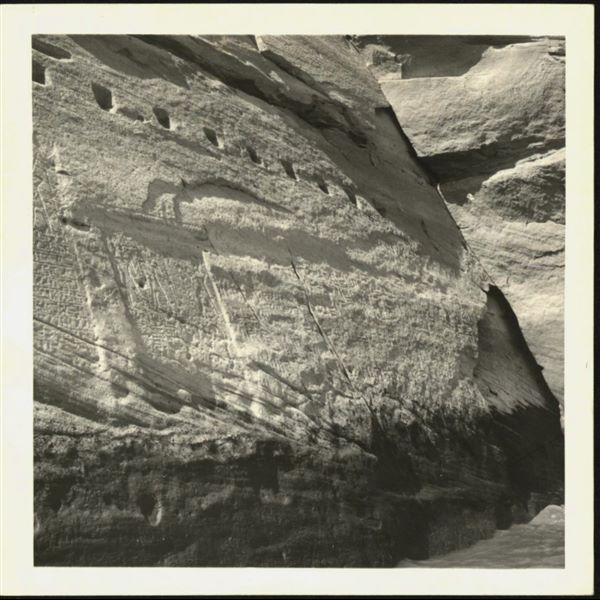
Photograph of the façade (right side) of the rock-cut Temple of Ellesiya, during the rising of Lake Nasser, which would have submerged this area. As can be seen at the bottom right, the water had already reached the temple’s façade.

Working at the Temple of Ellesiya. In front of the entrance there is some scaffolding that was used to remove parts of the temple. Note that the water level has almost reached the temple’s entrance, resulting in a real race against time to remove the walls, before the rising Lake Nasser submerged the entire area.
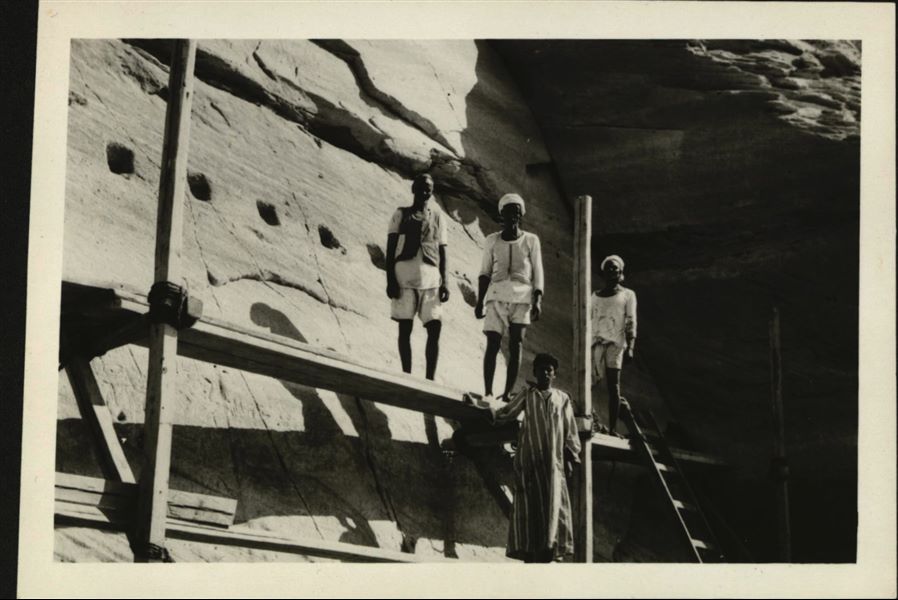
Photograph of four workers hired to work in the temple-moving team. The temple was cut into 66 blocks and reconstructed inside Museo Egizio in Turin, donated by the United Arab Republic to the Italian Republic.

Storage at Wadi es-Sebua, where the Temple of Ellesiya blocks were kept for a short time. The temple was cut into 66 pieces and saved from the rising Lake Nasser, which would soon flood the area.
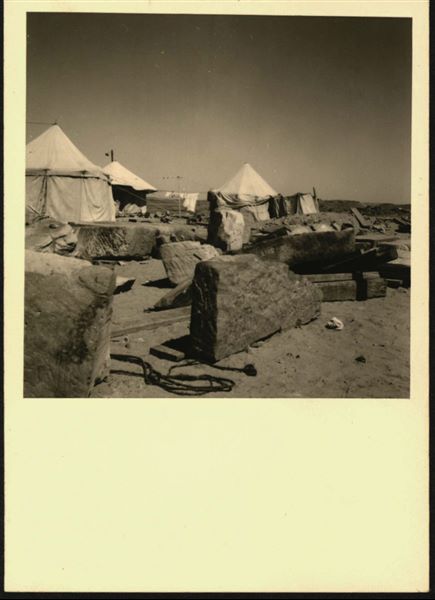
Storage at Wadi es-Sebua, where the Temple of Ellesiya blocks were kept for a short time. The temple was cut into 66 pieces and saved from the rising Lake Nasser, which would soon flood the area.

Storage at Wadi es-Sebua, where the Temple of Ellesiya blocks were kept for a short time. The temple was cut into 66 pieces and saved from the rising Lake Nasser, which would soon flood the area.
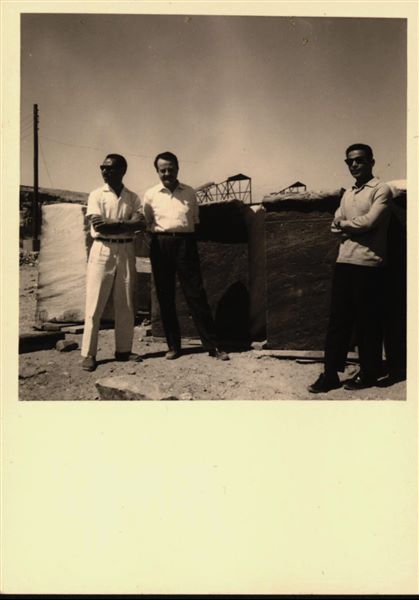
Storage at Wadi es-Sebua, where the Temple of Ellesiya blocks were kept for a short time. Here they are arranged in rows waiting to be transferred to Turin after the United Arab Republic decided to gift the temple to the Italian Republic. Standing in the foreground, two inspectors from the Egyptian Antiquities Service, and in the centre, Silvio Curto, who was the representative of Museo Egizio at the time.
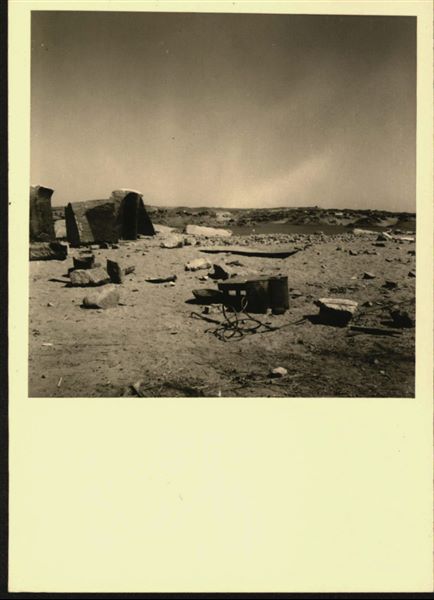
Storage at Wadi es-Sebua, where the Temple of Ellesiya blocks were kept for a short time. The temple was cut into 66 pieces and saved from the rising Lake Nasser, which would soon flood the area.
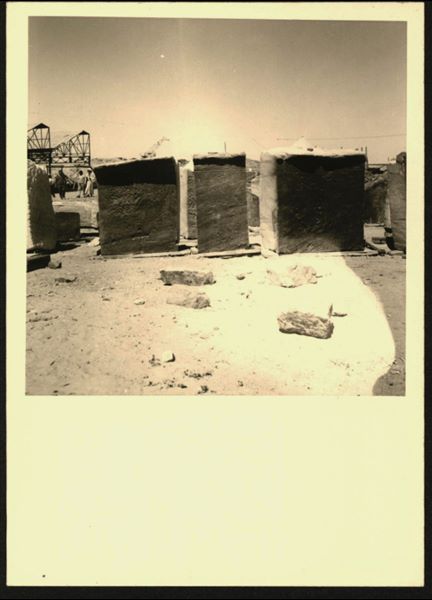
Storage at Wadi es-Sebua, where the Temple of Ellesiya blocks were kept for a short time. The temple was cut into 66 pieces (in the image, 3 blocks are visible) and saved from the rising Lake Nasser, which would soon flood the area.
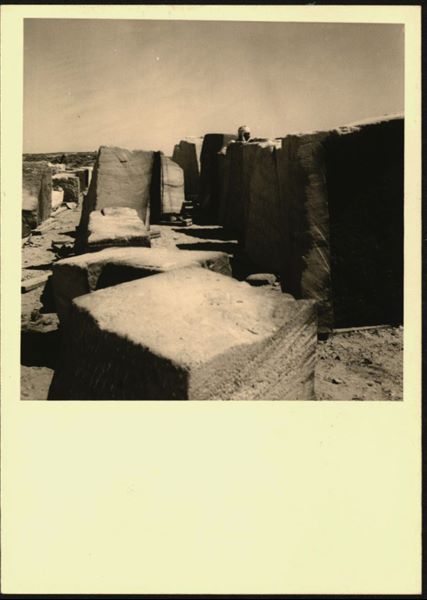
Storage at Wadi es-Sebua, where the Temple of Ellesiya blocks were kept for a short time, here they are arranged in rows waiting to be transferred to Turin, after the United Arab Republic decided to gift the temple to the Italian Republic.

Storage at Wadi es-Sebua, where the Temple of Ellesiya blocks were kept for a short time. Here they are arranged in rows waiting to be transferred to Turin after the United Arab Republic decided to gift the temple to the Italian Republic.
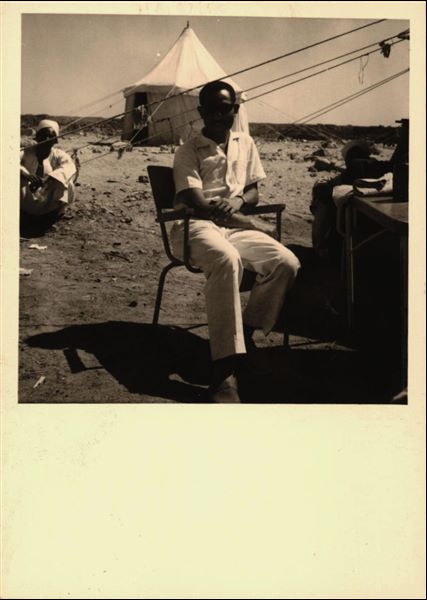
Storage at Wadi es-Sebua, where the Temple of Ellesiya blocks were kept for a short time. Here they are arranged in rows waiting to be transferred to Turin after the United Arab Republic decided to gift the temple to the Italian Republic. Photographed in the centre, an inspector of the Egyptian Antiquities Service.
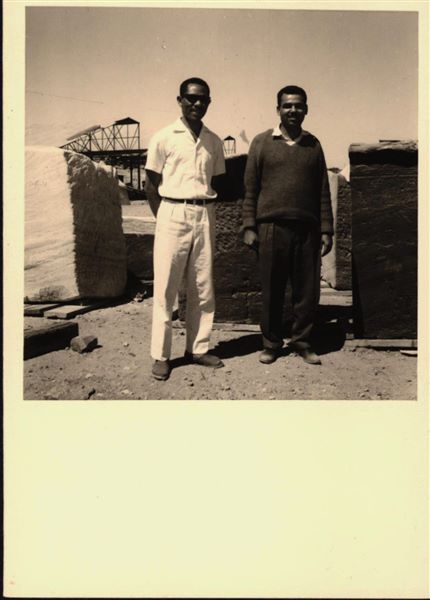
Storage at Wadi es-Sebua, where Temple of Ellesiya blocks were kept for a short time. Here they are arranged in rows waiting to be transferred to Turin after the United Arab Republic decided to gift the temple to the Italian Republic. Photographed in the foreground, two inspectors from the Egyptian Antiquities Service.
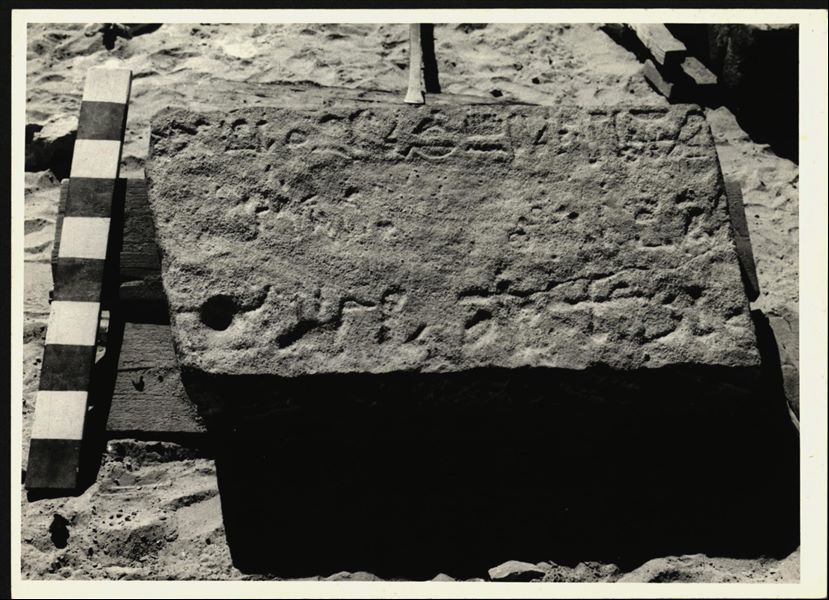
Storage at Wadi es-Sebua, one of the 66 blocks from the Temple of Ellesiya stored waiting to be transported to Turin, after the United Arab Republic decided to gift the temple to the Italian Republic. One of the blocks forming part of the right side of the recess, on the temple's exterior façade.

Storage at Wadi es-Sebua, one of the 66 blocks from the Temple of Ellesiya stored waiting to be transported to Turin, after the United Arab Republic decided to gift the temple to the Italian Republic. Wall scene from the left side of the chapel, with Thutmosis III offering incense to Amun-Ra, seated on a throne.
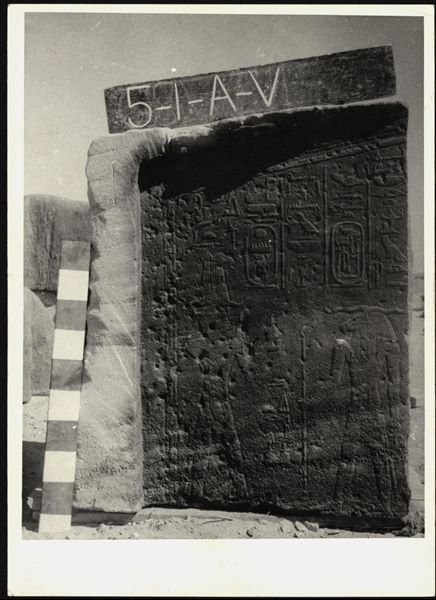
Storage at Wadi es-Sebua, one of the 66 blocks from the Temple of Ellesiya stored waiting to be transported to Turin, after the United Arab Republic decided to gift the temple to the Italian Republic. Wall scene from the left side of the transverse hall showing Thutmosis III and the god Khnum.
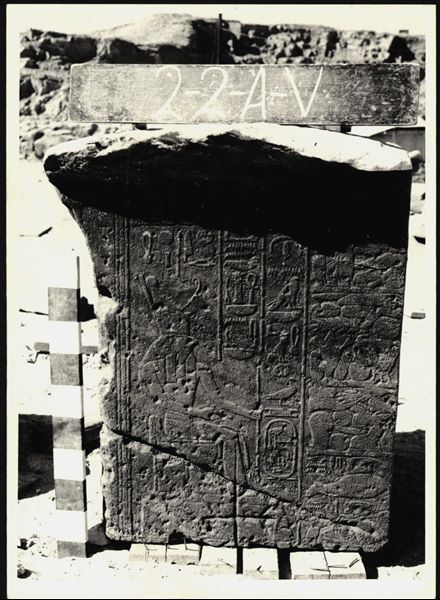
Storage at Wadi es-Sebua, one of the 66 blocks from the Temple of Ellesiya stored waiting to be transported to Turin, after the United Arab Republic decided to gift the temple to the Italian Republic. Scene from the back right wall of the transverse hall, showing Horus of Miam in front of a pile of offerings. An engraving of a Christian cross can be seen at the bottom.

Storage at Wadi es-Sebua, one of the 66 blocks from the Temple of Ellesiya stored waiting to be transported to Turin, after the United Arab Republic decided to gift the temple to the Italian Republic. Scene from the back right wall of the transverse hall, showing Thutmosis III near a pile of offerings, which is in front of the subject depicted in photo C2_9_130.
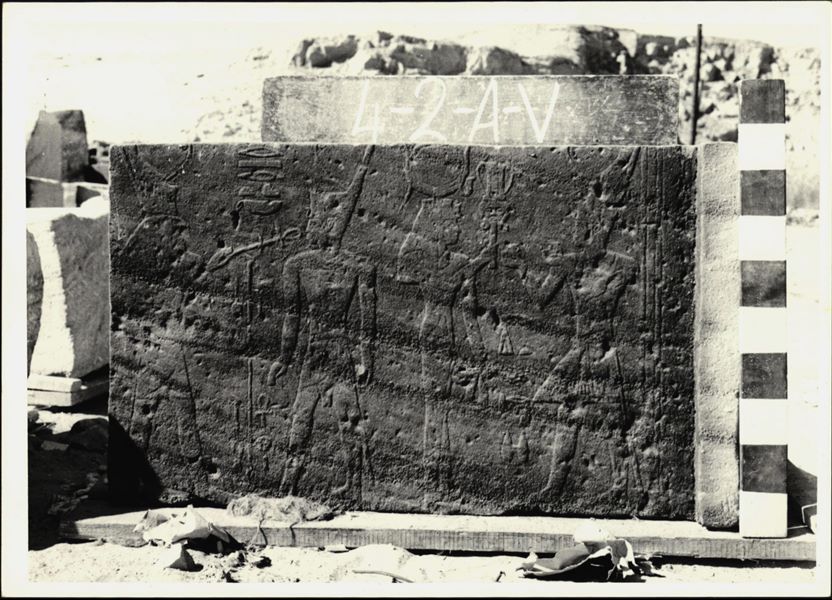
Storage at Wadi es-Sebua, one of the 66 blocks from the Temple of Ellesiya stored waiting to be transported to Turin, after the United Arab Republic decided to gift the temple to the Italian Republic. Scene from the right wall of the transverse hall, depicting Horus of Buhen, Thutmosis III, Hathor and Thutmosis III again.

Storage at Wadi es-Sebua, one of the 66 blocks from the Temple of Ellesiya stored waiting to be transported to Turin, after the United Arab Republic decided to gift the temple to the Italian Republic. Block to be placed in the bottom of the chapel, at the foot of the three statues carved into the rock.
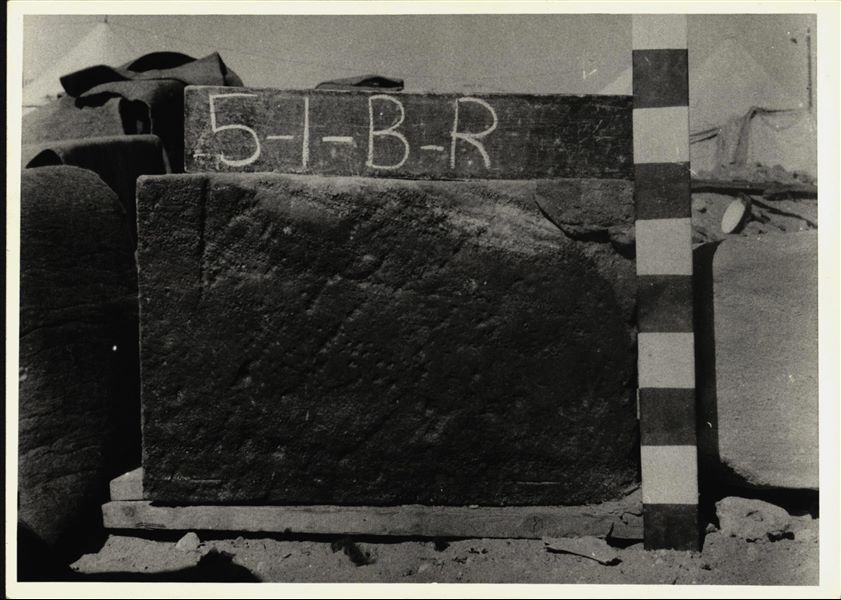
Storage at Wadi es-Sebua, one of the 66 blocks from the Temple of Ellesiya stored waiting to be transported to Turin, after the United Arab Republic decided to gift the temple to the Italian Republic. Scene depicting the Viceroy Setau praying to Amun-Ra and Horus, right wall of the chapel.
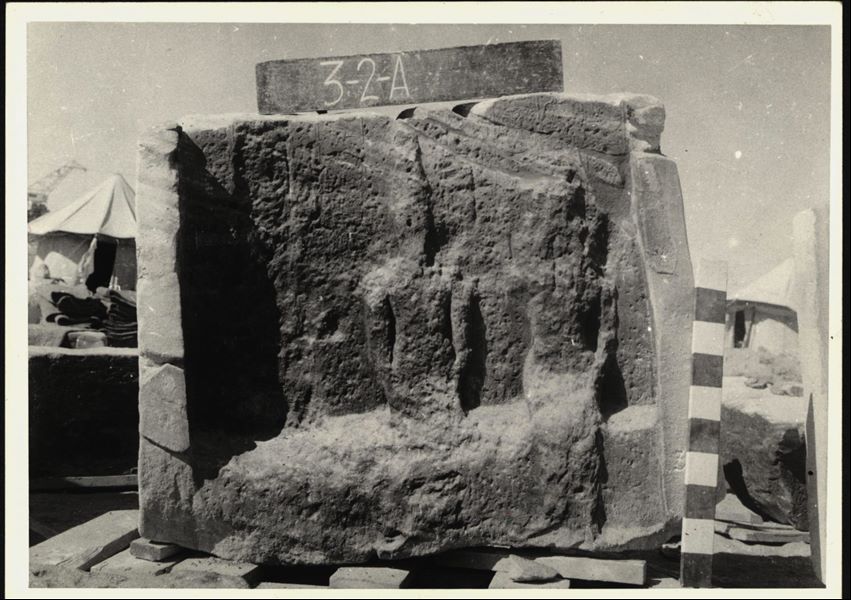
Storage at Wadi es-Sebua, one of the 66 blocks from the Temple of Ellesiya stored waiting to be transported to Turin, after the United Arab Republic decided to gift the temple to the Italian Republic. The block is part of the back temple wall with the remains of the three rock-carved statues depicting Amun of Miam, Thutmosis III and Satet.
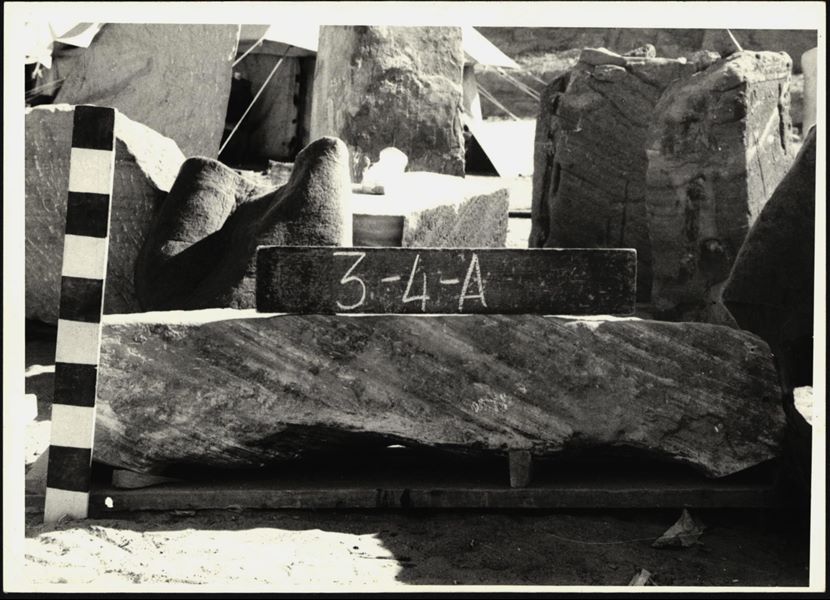
Storage at Wadi es-Sebua, one of the 66 blocks from the Temple of Ellesiya stored waiting to be transported to Turin, after the United Arab Republic decided to gift the temple to the Italian Republic.
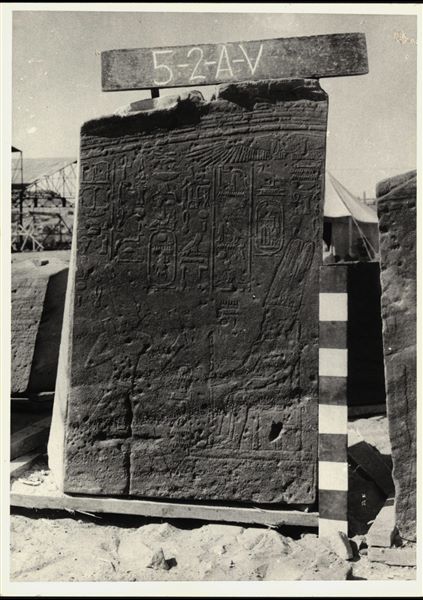
Storage at Wadi es-Sebua, one of the 66 blocks from the Temple of Ellesiya stored waiting to be transported to Turin, after the United Arab Republic decided to gift the temple to the Italian Republic. This scene is located on the left wall of the transverse hall and depicts Thutmosis III standing before of Amun-Ra. A Christian cross is clearly visible.
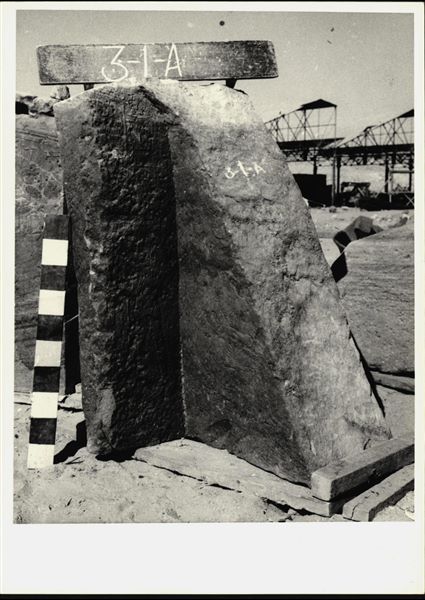
Storage at Wadi es-Sebua, one of the 66 blocks from the Temple of Ellesiya stored waiting to be transported to Turin, after the United Arab Republic decided to gift the temple to the Italian Republic. Back wall forming a corner with the right wall of the chapel. A personified image of the southern Nile god is just visible on the back wall.

Storage at Wadi es-Sebua, one of the 66 blocks from the Temple of Ellesiya stored waiting to be transported to Turin, after the United Arab Republic decided to gift the temple to the Italian Republic. Left sidewall of the transverse hall, with Thutmosis III and the god Min.
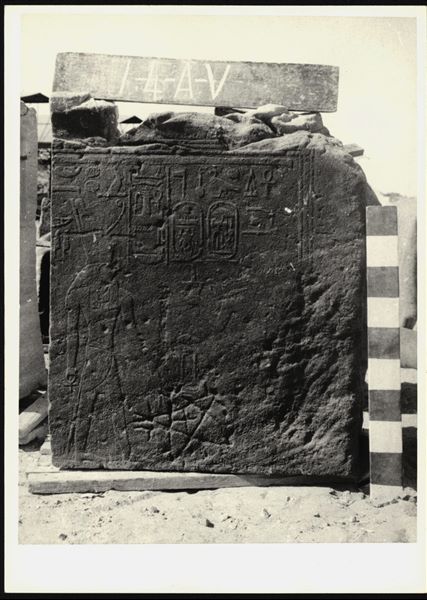
Storage at Wadi es-Sebua, one of the 66 blocks from the Temple of Ellesiya stored waiting to be transported to Turin, after the United Arab Republic decided to gift the temple to the Italian Republic. Wall scene to the right of the transverse hall’s entrance, with the pharaoh on the right offering incense to the god Horus of Nekhen. At the bottom, there is an engraving of a five-pointed Judaic star, with a Christian cross incised within it.
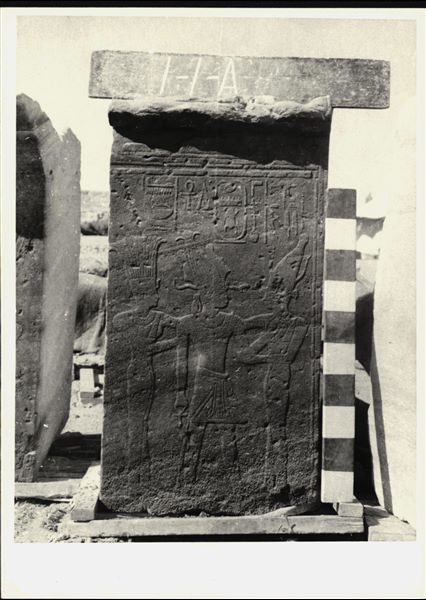
Storage at Wadi es-Sebua, one of the 66 blocks from the Temple of Ellesiya stored waiting to be transported to Turin, after the United Arab Republic decided to gift the temple to the Italian Republic. Wall scene to the left of the transverse hall’s entrance, where Pharaoh Thutmosis III, wearing the Atef crown, is shown between the goddess Anuket (left) and the goddess Satet (right); goddesses of the cataract at Aswan.
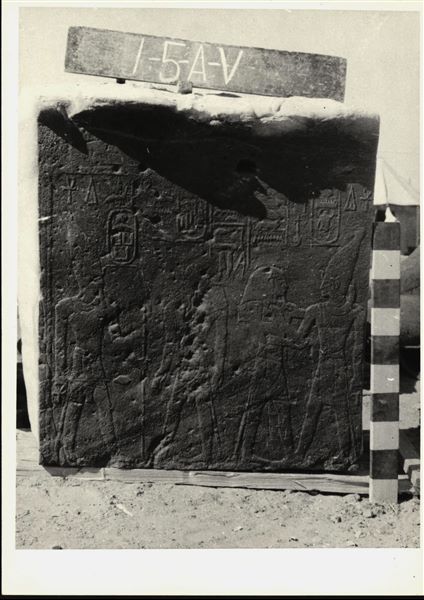
Storage at Wadi es-Sebua, one of the 66 blocks from the Temple of Ellesiya stored waiting to be transported to Turin, after the United Arab Republic decided to gift the temple to the Italian Republic. Wall scene to the right of the transverse hall’s entrance, and depicted from left to right are: Sesostris III wearing the white crown, worshipped by Thutmosis III, and the god Dedun embracing Thutmosis III wearing the white crown. A Christian cross is also visible.
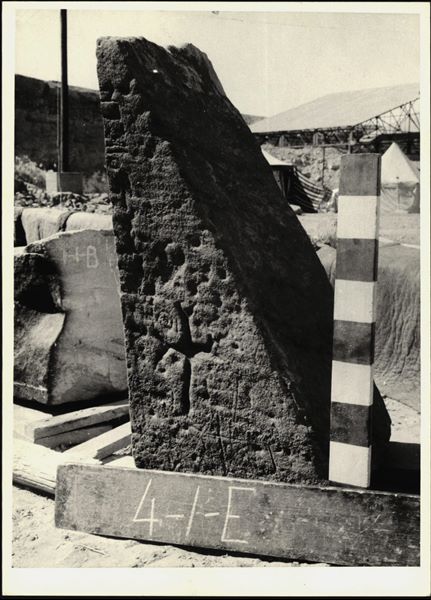
Storage at Wadi es-Sebua, one of the 66 blocks from the Temple of Ellesiya stored waiting to be transported to Turin, after the United Arab Republic decided to gift the temple to the Italian Republic. The block shows a very clearly engraved Christian cross on the right side of the entrance to the temple, the wall facing the entrance.

Storage at Wadi es-Sebua, one of the 66 blocks from the Temple of Ellesiya stored waiting to be transported to Turin, after the United Arab Republic decided to gift the temple to the Italian Republic. Scene to the left of the transverse hall’s entrance, depicting the god Horus of Miam holding Pharaoh Thutmosis III’s hand.
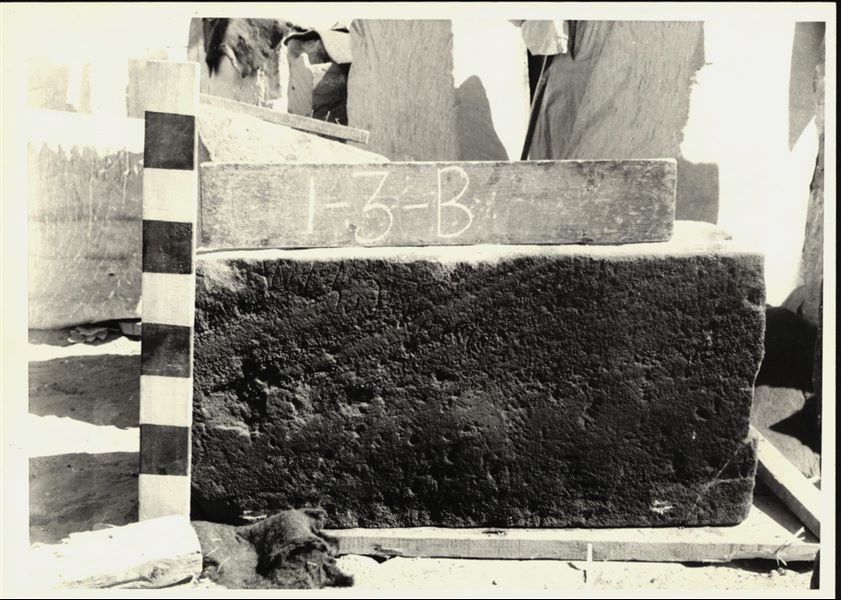
Storage at Wadi es-Sebua, one of the 66 blocks from the Temple of Ellesiya stored waiting to be transported to Turin, after the United Arab Republic decided to gift the temple to the Italian Republic.

Storage at Wadi es-Sebua, one of the 66 blocks from the Temple of Ellesiya stored waiting to be transported to Turin, after the United Arab Republic decided to gift the temple to the Italian Republic.

Storage at Wadi es-Sebua, one of the 66 blocks from the Temple of Ellesiya stored waiting to be transported to Turin, after the United Arab Republic decided to gift the temple to the Italian Republic.

Storage at Wadi es-Sebua, one of the 66 blocks from the Temple of Ellesiya stored waiting to be transported to Turin, after the United Arab Republic decided to gift the temple to the Italian Republic.
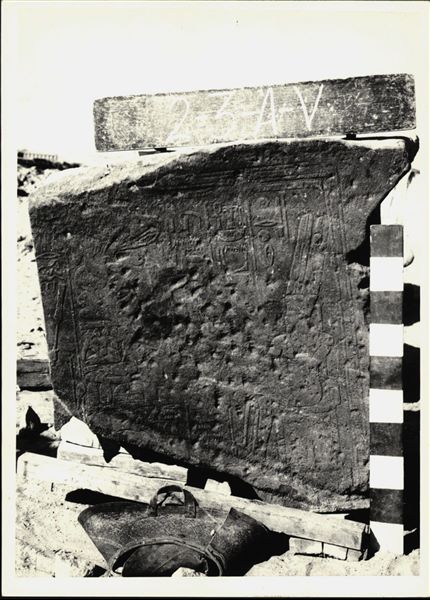
Storage at Wadi es-Sebua, one of the 66 blocks from the Temple of Ellesiya stored waiting to be transported to Turin, after the United Arab Republic decided to gift the temple to the Italian Republic. Scene on the back left wall of the transverse hall, showing the god Amun-Ra seated on a throne in front of a pile of offerings.

Two of the 66 blocks from the Temple of Ellesiya. Scene on the back left wall of the transverse hall (opening to the right of the chapel), depicting the god Amun-Ra seated on a throne in front of a pile of offerings. Below the wall scene, a Christian cross is visible.
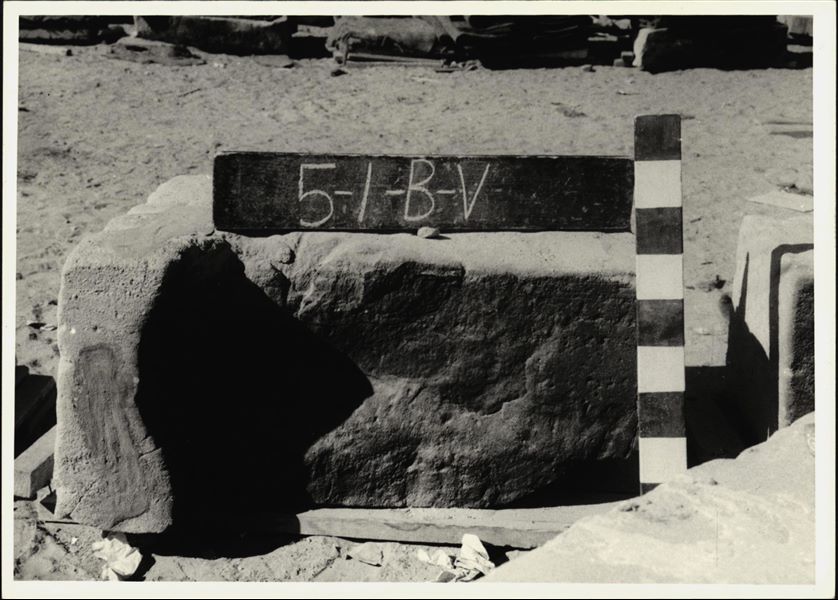
Storage at Wadi es-Sebua, one of the 66 blocks from the Temple of Ellesiya stored waiting to be transported to Turin, after the United Arab Republic decided to gift the temple to the Italian Republic.

Storage at Wadi es-Sebua, one of the 66 blocks from the Temple of Ellesiya stored waiting to be transported to Turin, after the United Arab Republic decided to gift the temple to the Italian Republic.
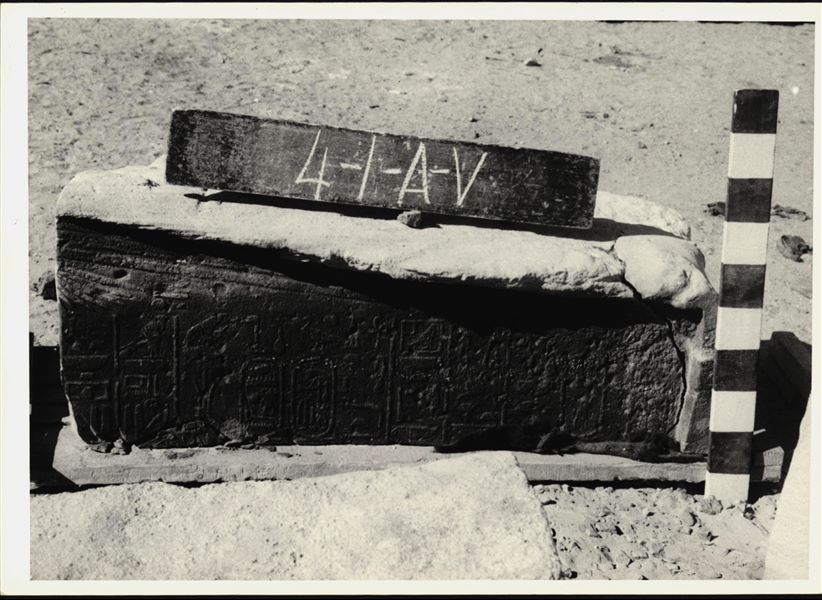
Storage at Wadi es-Sebua, one of the 66 blocks from the Temple of Ellesiya stored waiting to be transported to Turin, after the United Arab Republic decided to gift the temple to the Italian Republic. Upper register with inscriptions, from the right wall of the transverse hall.
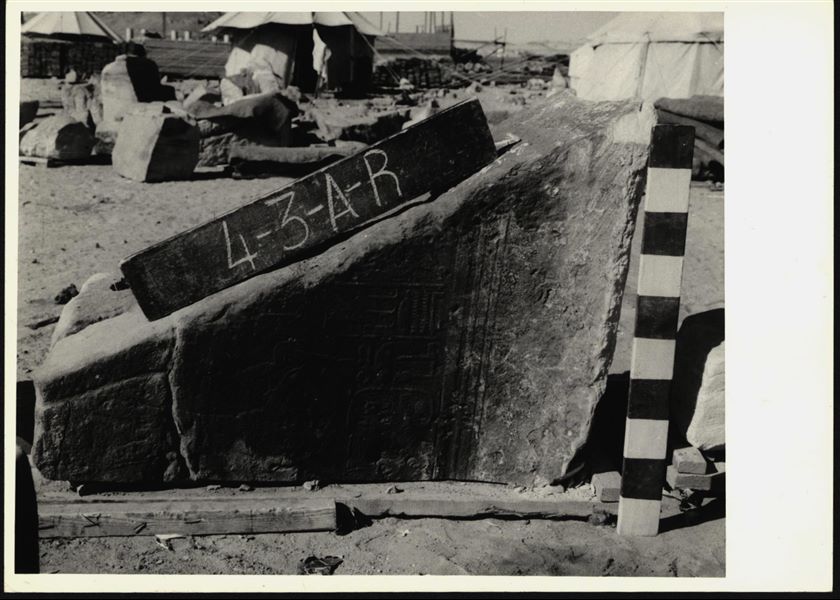
Storage at Wadi es-Sebua, one of the 66 blocks from the Temple of Ellesiya stored waiting to be transported to Turin, after the United Arab Republic decided to gift the temple to the Italian Republic. Right wall of the chamber, depicting Pharaoh Thutmosis III offering a cone shaped loaf of bread to the god Thoth, who isn’t visible on this block.
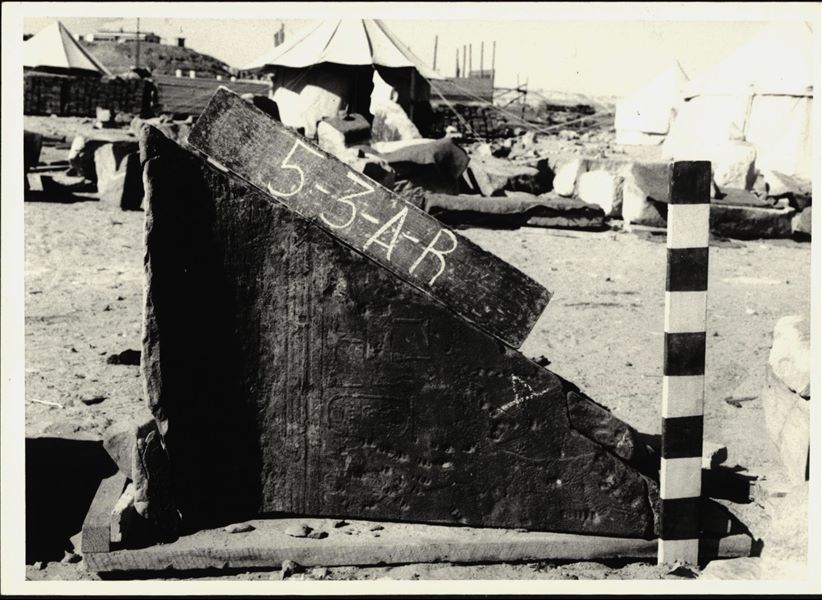
Storage at Wadi es-Sebua, one of the 66 blocks from the Temple of Ellesiya stored waiting to be transported to Turin, after the United Arab Republic decided to gift the temple to the Italian Republic. Left wall of the chapel, depicting Pharaoh Thutmosis III offering milk to the goddess Satet, who isn’t visible on this block.
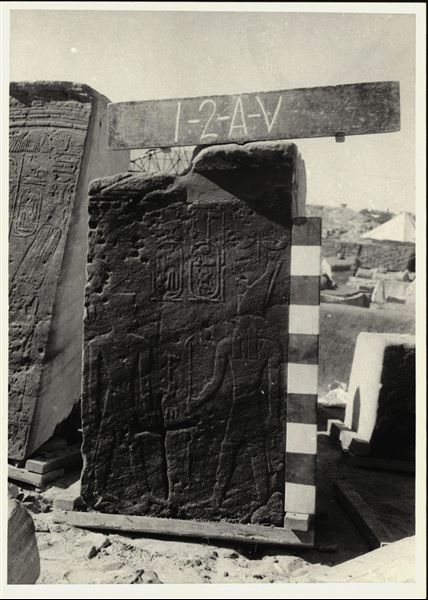
Storage at Wadi es-Sebua, one of the 66 blocks from the Temple of Ellesiya stored waiting to be transported to Turin, after the United Arab Republic decided to gift the temple to the Italian Republic. Wall to the left of the entrance, depicting Thutmosis III and the god Horus of Baki. A Christian cross has been engraved in the middle of the scene.

Storage at Wadi es-Sebua, one of the 66 blocks from the Temple of Ellesiya stored waiting to be transported to Turin, after the United Arab Republic decided to gift the temple to the Italian Republic. Left wall of the chapel, forming a corner with the back of the chapel, with a depiction of the goddess Satet.

Storage at Wadi es-Sebua, one of the 66 blocks from the Temple of Ellesiya stored waiting to be transported to Turin, after the United Arab Republic decided to gift the temple to the Italian Republic. Lower register from the left wall of the chapel, where there are some inscriptions.
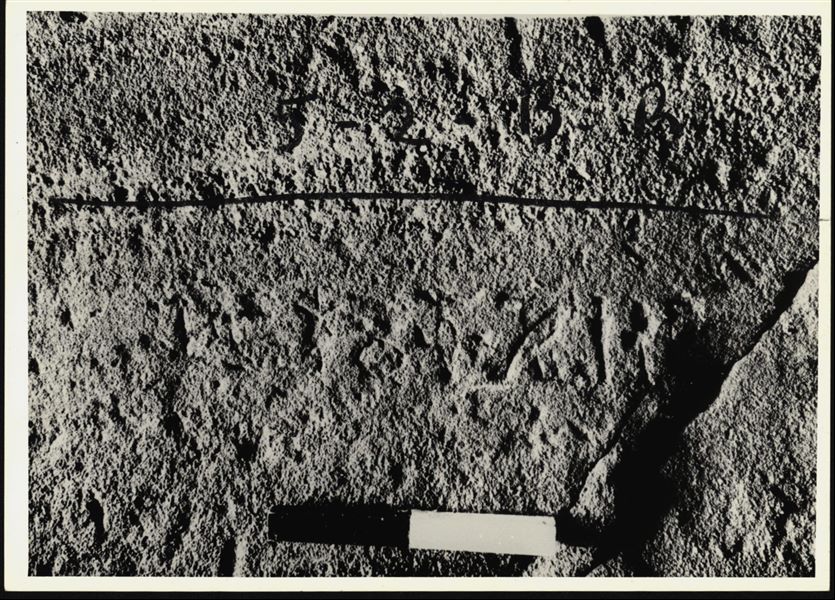
Detail of an inscription on the lower register of the left chapel wall, from the rock-cut Temple of Ellesiya.

Storage at Wadi es-Sebua, one of the 66 blocks from the Temple of Ellesiya stored waiting to be transported to Turin, after the United Arab Republic decided to gift the temple to the Italian Republic. Lower block at the corner of the left wall and the bottom of the chapel.
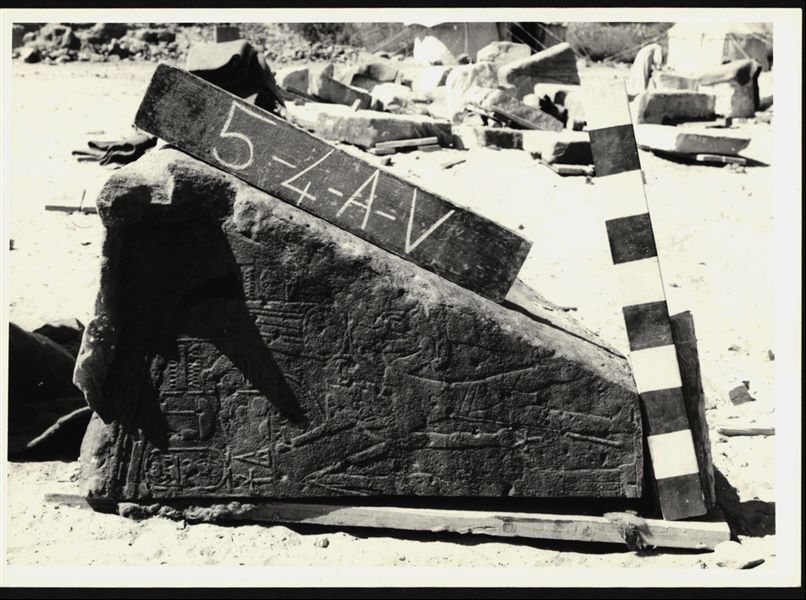
Storage at Wadi es-Sebua, one of the 66 blocks from the Temple of Ellesiya stored waiting to be transported to Turin, after the United Arab Republic decided to gift the temple to the Italian Republic. Left wall of the transverse hall, Pharaoh Thutmosis III (left) and the god Montu (right) are depicted.
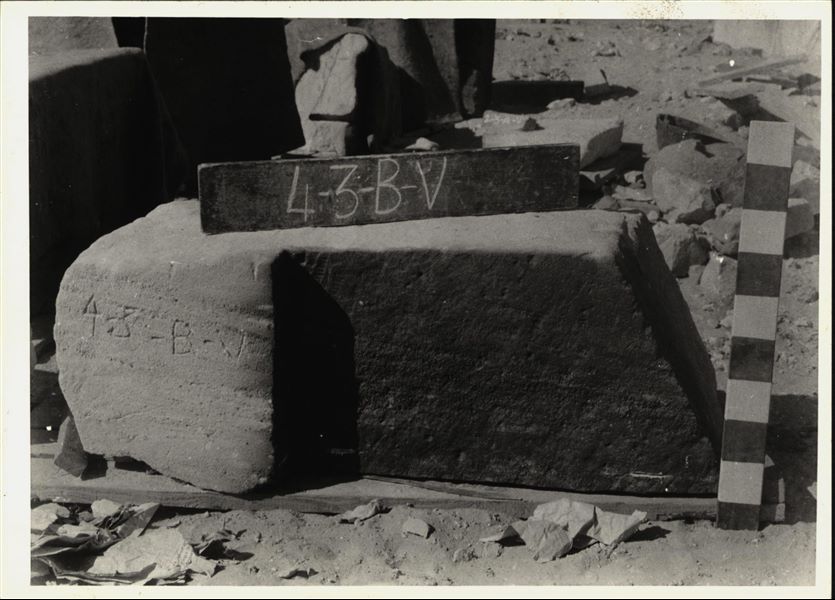
Storage at Wadi es-Sebua, one of the 66 blocks from the Temple of Ellesiya stored waiting to be transported to Turin, after the United Arab Republic decided to gift the temple to the Italian Republic. Lower block from the right wall of the transverse hall forming a corner with the right side of the transverse hall’s back wall.

Storage at Wadi es-Sebua, one of the 66 blocks from the Temple of Ellesiya stored waiting to be transported to Turin, after the United Arab Republic decided to gift the temple to the Italian Republic. Back left wall of the transverse hall, forming a corner with the left wall of the same room, depicting the goddess Isis-Serket as she embraces the Pharaoh Thutmosis III. On the right is the Pharaoh again, in a scene connected with the god Amun-Ra, who isn’t visible on this block.

Storage at Wadi es-Sebua, one of the 66 blocks from the Temple of Ellesiya stored waiting to be transported to Turin, after the United Arab Republic decided to gift the temple to the Italian Republic. Right wall of the transverse hall, showing on the left: Horus of Miam in front of Thutmosis III, who offers wine to the deity, and on the right, the Pharaoh sits between two deities who are crowning him; the goddesses Wadjet (left) and Nekhbet (right), the “Two Ladies”, goddesses of Lower and Upper Egypt respectively.
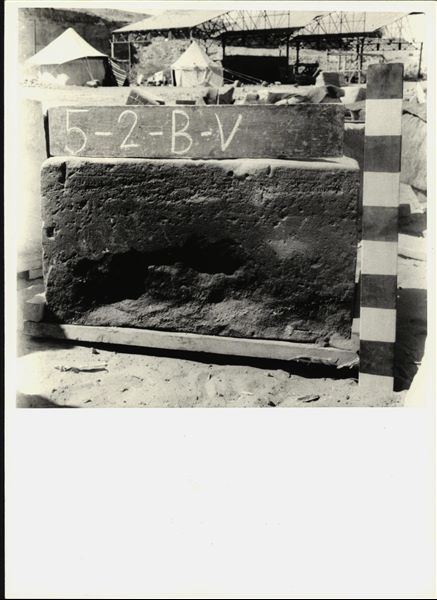
Storage at Wadi es-Sebua, one of the 66 blocks from the Temple of Ellesiya stored waiting to be transported to Turin, after the United Arab Republic decided to gift the temple to the Italian Republic. Lower block of the left wall of the transverse hall.
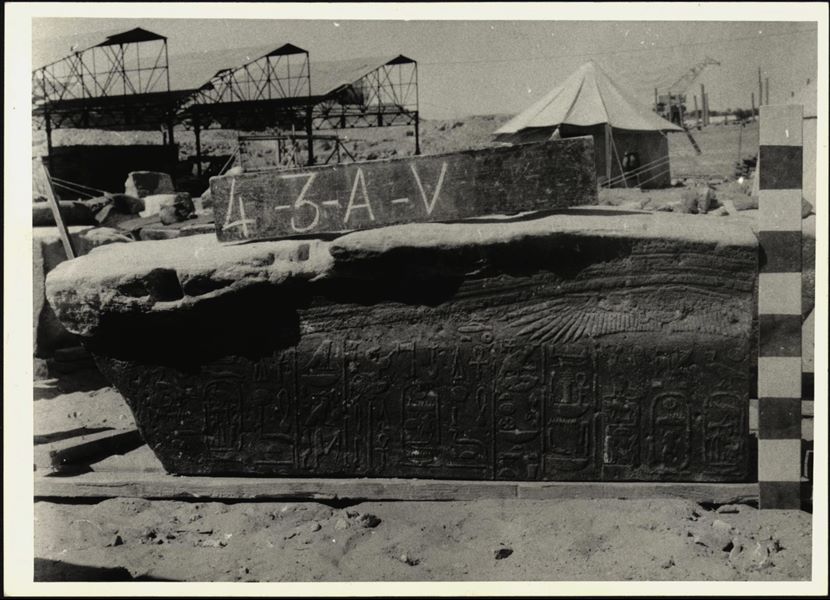
Storage at Wadi es-Sebua, one of the 66 blocks from the Temple of Ellesiya stored waiting to be transported to Turin, after the United Arab Republic decided to gift the temple to the Italian Republic. Upper register from the right wall of the transverse hall, showing hieroglyphic inscriptions.

Storage at Wadi es-Sebua, one of the 66 blocks from the Temple of Ellesiya stored waiting to be transported to Turin, after the United Arab Republic decided to gift the temple to the Italian Republic. Lower block from the left side of the back of the transverse hall, showing hieroglyphic inscriptions.
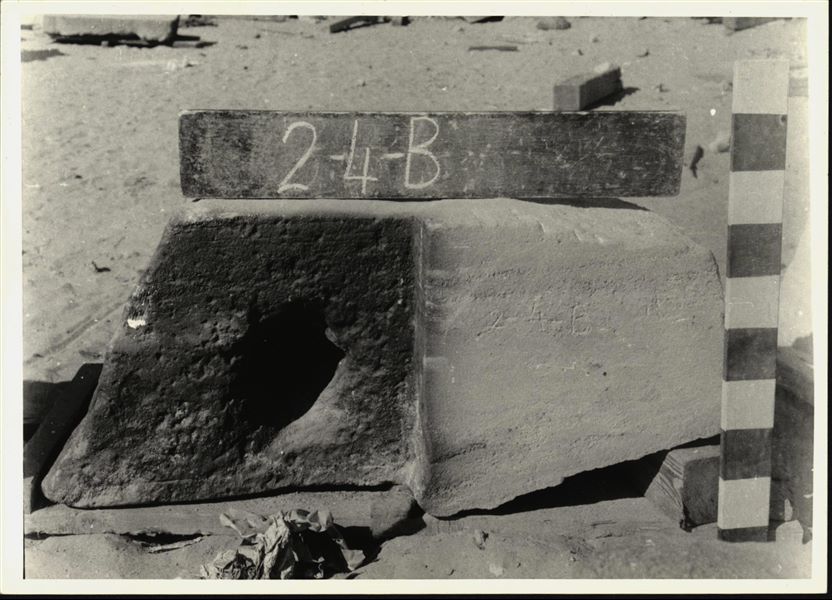
Storage at Wadi es-Sebua, one of the 66 blocks from the Temple of Ellesiya stored waiting to be transported to Turin, after the United Arab Republic decided to gift the temple to the Italian Republic. Lower block from the left wall of the transverse hall, forming a corner with the left side of the back of the same transverse hall.
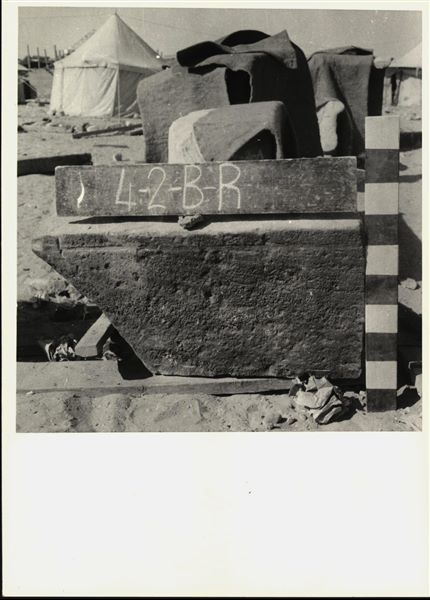
Storage at Wadi es-Sebua, one of the 66 blocks from the Temple of Ellesiya stored waiting to be transported to Turin, after the United Arab Republic decided to gift the temple to the Italian Republic. Lower block from the right wall of the chapel.

Storage at Wadi es-Sebua, one of the 66 blocks from the Temple of Ellesiya stored waiting to be transported to Turin, after the United Arab Republic decided to gift the temple to the Italian Republic. Right wall from the chapel, pharaoh Thutmosis III is visible on the right, offering milk to Horus of Miam, who is barely visible due to the poor condition of the block.
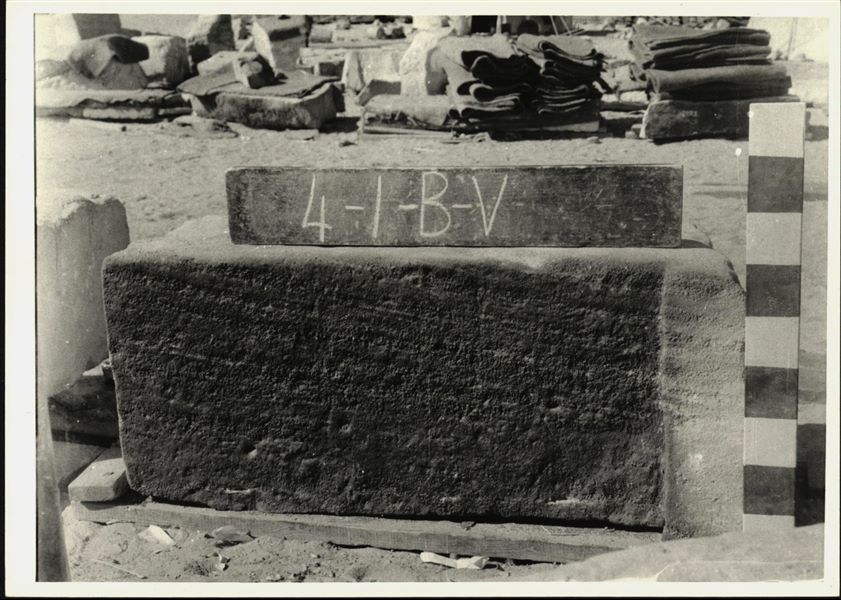
Storage at Wadi es-Sebua, one of the 66 blocks from the Temple of Ellesiya stored waiting to be transported to Turin, after the United Arab Republic decided to gift the temple to the Italian Republic.
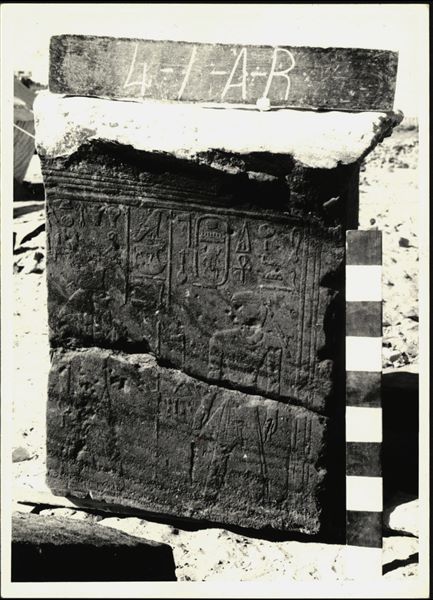
Storage at Wadi es-Sebua, one of the 66 blocks from the Temple of Ellesiya stored waiting to be transported to Turin, after the United Arab Republic decided to gift the temple to the Italian Republic. Right wall from the chapel, depicting Horus on the left and Thutmosis III on the right.

Storage at Wadi es-Sebua, one of the 66 blocks from the Temple of Ellesiya stored waiting to be transported to Turin, after the United Arab Republic decided to gift the temple to the Italian Republic. Lower block from the right wall of the transverse hall.
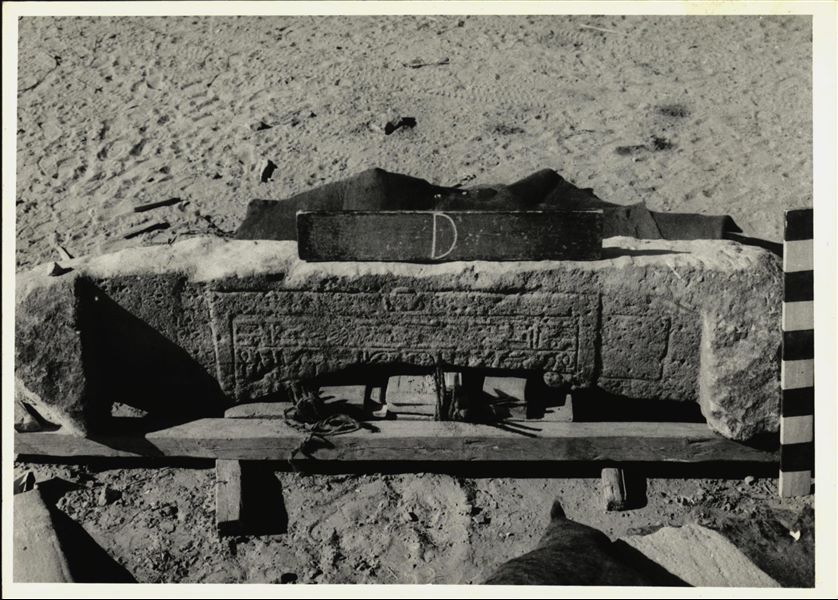
Storage at Wadi es-Sebua, one of the 66 blocks from the Temple of Ellesiya stored waiting to be transported to Turin, after the United Arab Republic decided to gift the temple to the Italian Republic. External architrave from the entrance to the antechamber of the temple.
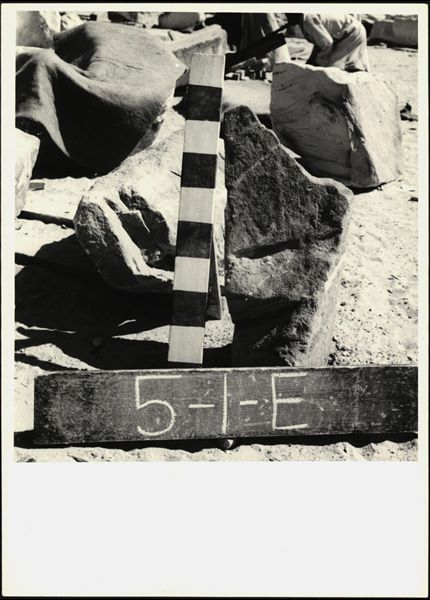
Storage at Wadi es-Sebua, one of the 66 blocks from the Temple of Ellesiya stored waiting to be transported to Turin, after the United Arab Republic decided to gift the temple to the Italian Republic.
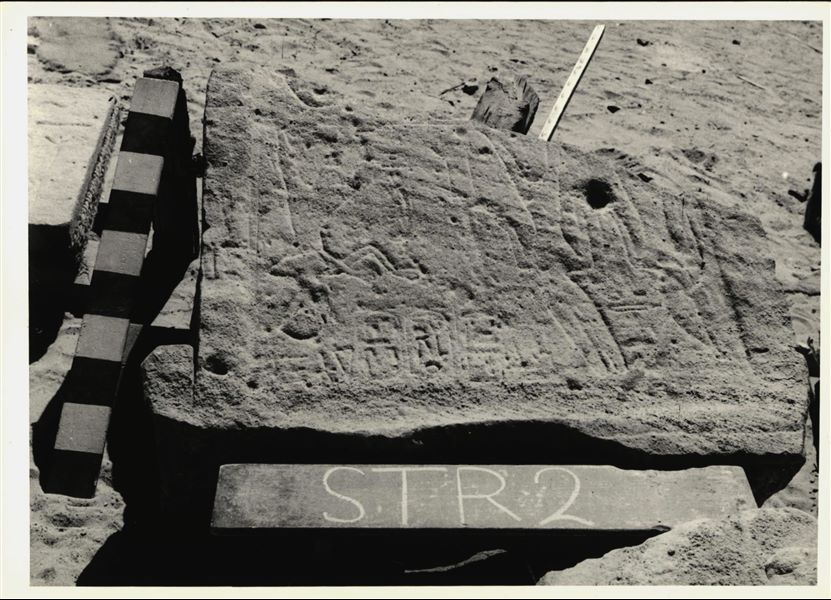
Storage at Wadi es-Sebua, one of the 66 blocks from the Temple of Ellesiya stored waiting to be transported to Turin, after the United Arab Republic decided to gift the temple to the Italian Republic. Restoration Stela, on the façade to the right of the entrance, commissioned by Ramesses II, who is depicted on the right, while on the left is Amun-Ra in front of Horus of Miam.

Storage at Wadi es-Sebua, one of the 66 blocks from the Temple of Ellesiya stored waiting to be transported to Turin, after the United Arab Republic decided to gift the temple to the Italian Republic. Lower block of the so-called Restoration Stela.
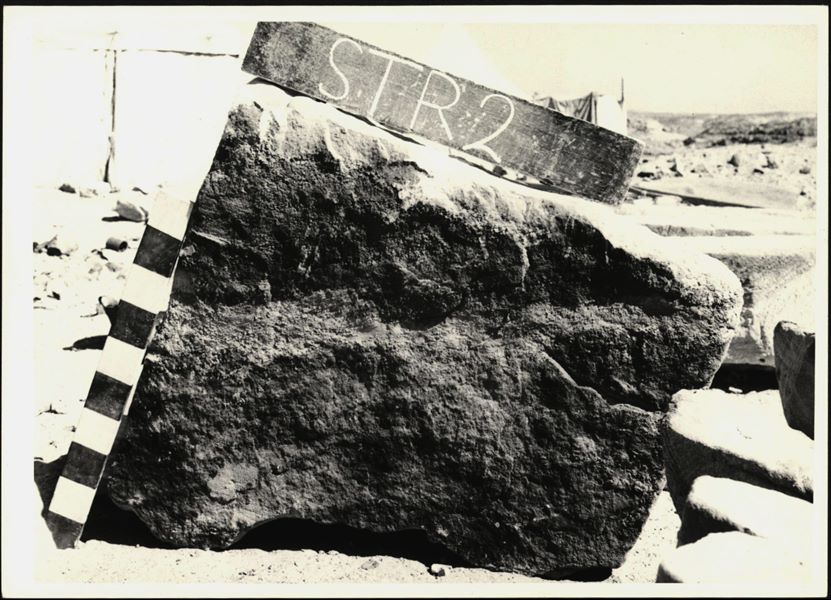
Storage at Wadi es-Sebua, one of the 66 blocks from the Temple of Ellesiya stored waiting to be transported to Turin, after the United Arab Republic decided to gift the temple to the Italian Republic.

Storage at Wadi es-Sebua, one of the 66 blocks from the Temple of Ellesiya stored waiting to be transported to Turin, after the United Arab Republic decided to gift the temple to the Italian Republic.
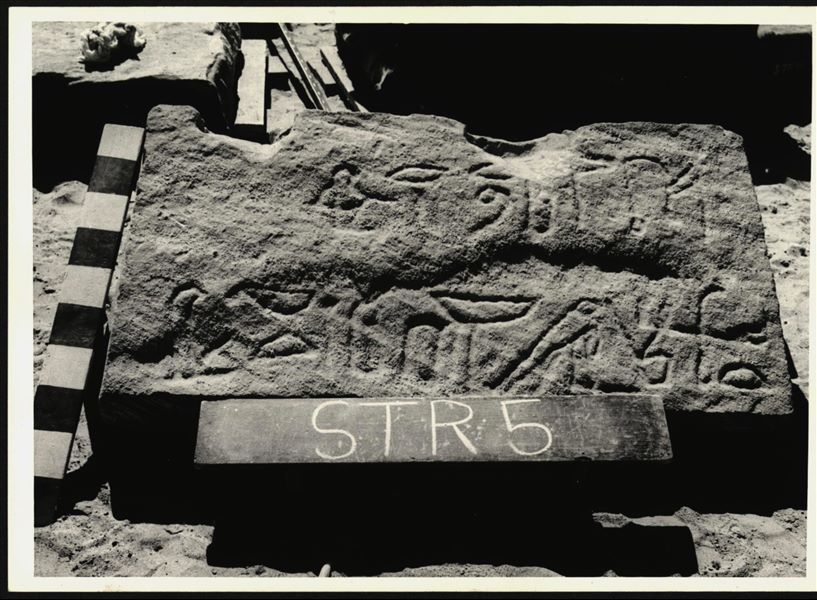
Storage at Wadi es-Sebua, one of the 66 blocks from the Temple of Ellesiya stored waiting to be transported to Turin, after the United Arab Republic decided to gift the temple to the Italian Republic. One of the blocks forming part of the right side of the recess, on the temple's exterior façade.
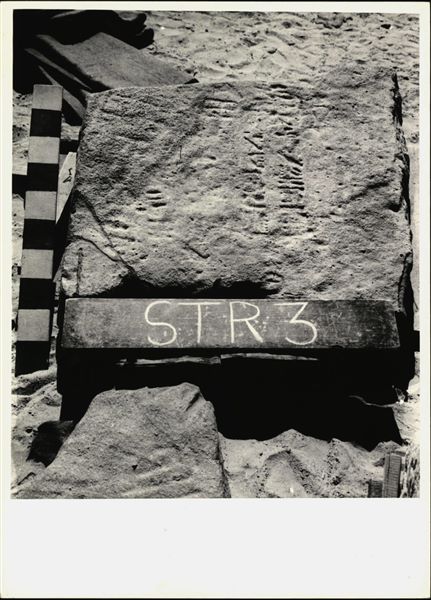
Storage at Wadi es-Sebua, one of the 66 blocks from the Temple of Ellesiya stored waiting to be transported to Turin, after the United Arab Republic decided to gift the temple to the Italian Republic. One of the blocks forming part of the right side of the recess, on the temple's exterior façade.

Storage at Wadi es-Sebua, one of the 66 blocks from the Temple of Ellesiya stored waiting to be transported to Turin, after the United Arab Republic decided to gift the temple to the Italian Republic. One of the blocks forming part of the right side of the recess, on the temple's exterior façade.
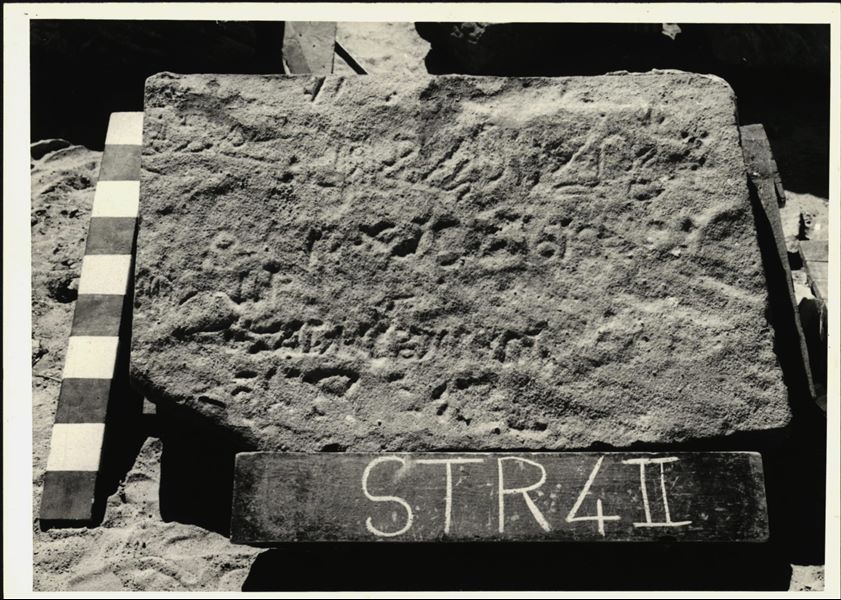
Storage at Wadi es-Sebua, one of the 66 blocks from the Temple of Ellesiya stored waiting to be transported to Turin, after the United Arab Republic decided to gift the temple to the Italian Republic. One of the blocks forming part of the right side of the recess, on the temple's exterior façade.

Storage at Wadi es-Sebua, one of the 66 blocks from the Temple of Ellesiya stored waiting to be transported to Turin, after the United Arab Republic decided to gift the temple to the Italian Republic. One of the blocks forming part of the right side of the recess, on the temple's exterior façade.

Storage at Wadi es-Sebua, one of the 66 blocks from the Temple of Ellesiya stored waiting to be transported to Turin, after the United Arab Republic decided to gift the temple to the Italian Republic. Wall to the left of the entrance to the transverse chamber, with depictions of the two gods of the Aswan cataract, Anuket and Satet, with the Pharaoh in the centre.
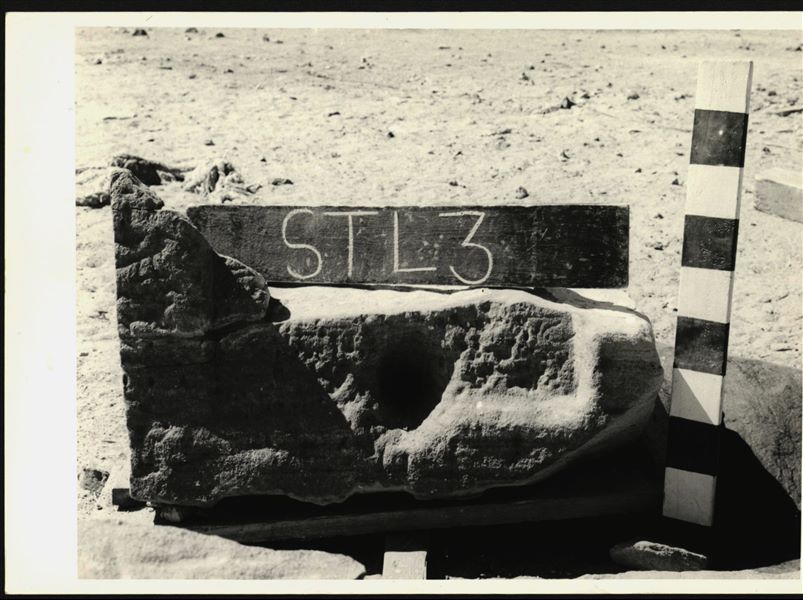
Storage at Wadi es-Sebua, one of the 66 blocks from the Temple of Ellesiya stored waiting to be transported to Turin, after the United Arab Republic decided to gift the temple to the Italian Republic. Lower block of one of the stelae carved on the left side of the temples’ external façade.

Storage at Wadi es-Sebua, one of the 66 blocks from the Temple of Ellesiya stored waiting to be transported to Turin, after the United Arab Republic decided to gift the temple to the Italian Republic. Lower block of one of the stelae carved on the left side of the temples’ external façade.